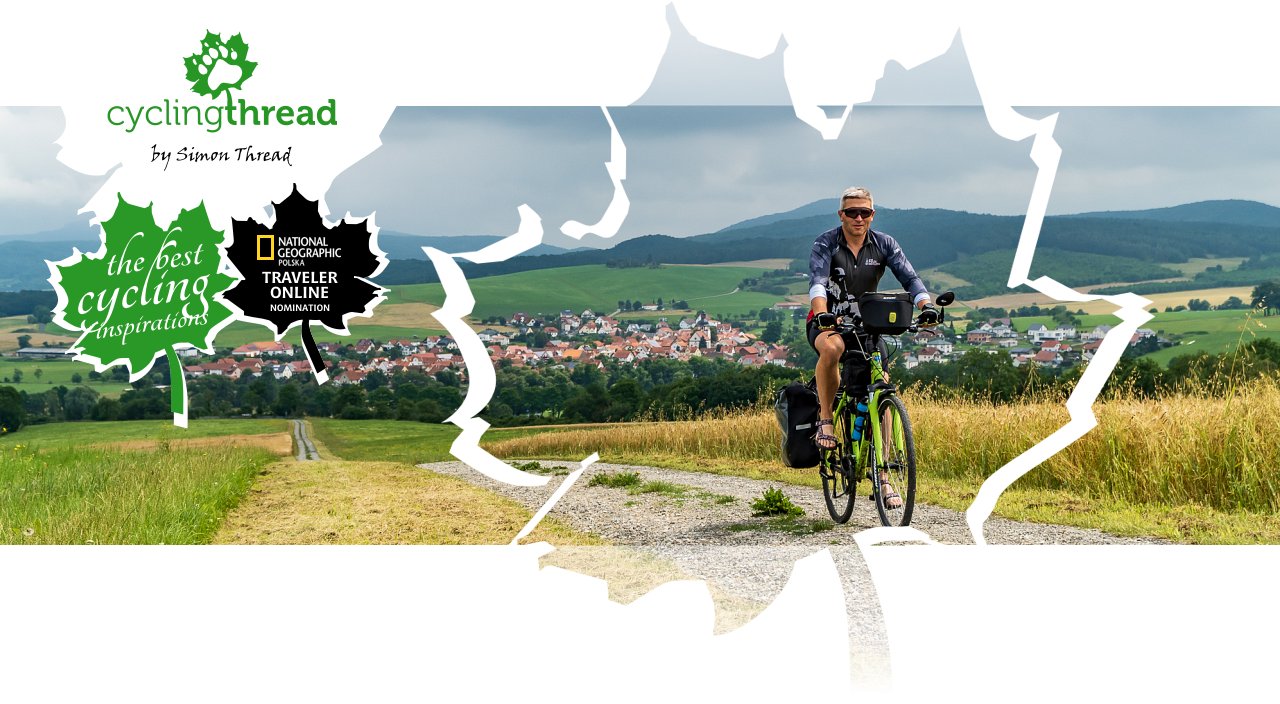
Hesse Railway Cycle Route. The German land of extinct volcanoes
Disused railway lines are widely used in many European regions for creating new cycling routes. Germany leads the way in repurposing old railway infrastructure, boasting over 5,500 kilometers of post-railway cycling paths. To see how Germany transforms these unused "iron roads" into recreational spaces, we visited the BahnRadweg Hessen - the Hesse Railway Cycle Route - the longest post-railway route in the country. As an added highlight, our railway journey took us through the largest post-volcanic landscape in Central Europe.
Route on the map
GPX file (GPS track): cyclingthread.com-hesse-2021.gpx
Hesse Railway Cycle Route - table of contents
- Railway routes: a cyclist’s delight
- Nearly 300 kilometers of railway cycling paths
- Scenic views shaped by Vogelsberg and Rhön
- The railway Vulkanradweg: the route’s starting point
- Over steep, wet cobblestones in Ortenberg
- 25 kilometers of climbing through volcanic Vogelsberg
- No bad weather, just...
- Hessian Tuscany along the bike route
- The only tourists among half-timbered houses in Lauterbach
- German castles and palaces in Hesse
- In Schlitz, the world’s largest candle shines
- A stretch along the Fulda river cycling route
- Approached by a friendly teacher in Fulda
- Car tires next to the relics of Germany's patron saint
- We’ll clear the way for you, dear cyclist…
- … and inform you about cycling detours
- Once trains, now bikes and bats
- The land of extinct volcanoes in the Rhön Mountains
- EuroVelo 13: the Iron Curtain Cycle Route
- The Fulda Gap along EuroVelo 13
- The hottest point of the Cold War
- A railway bike path through the Hessian Kegelspiel
- The impressive bridge on the cycling route
- The railway route ends in Bad Hersfeld
- Easy to get there from Frankfurt
- Hotel, guesthouse, two apartments, and a motel
- Plan your summer cycling trip in winter
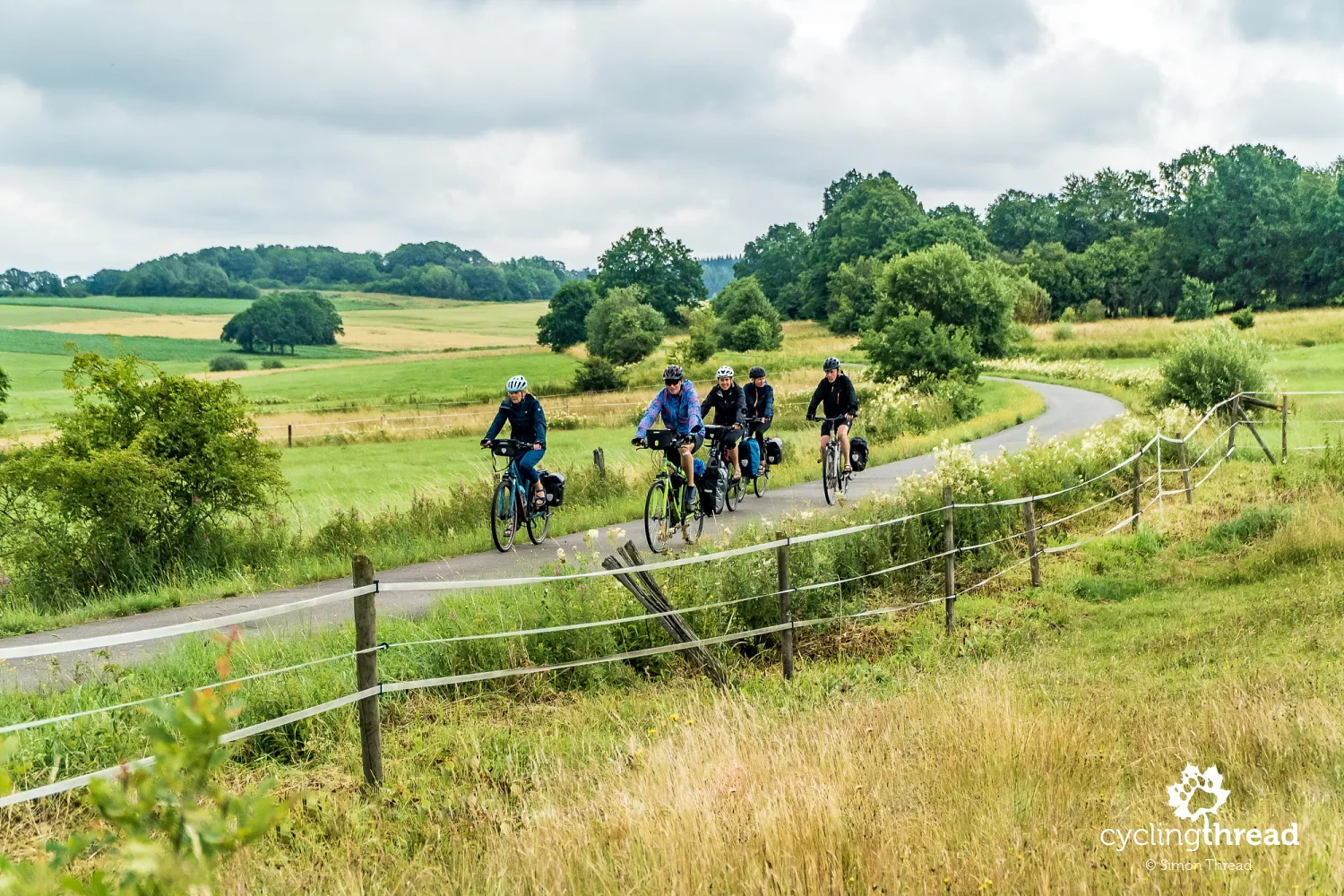
Railway routes: a cyclist’s delight
Cycling routes along former railway lines are always a real treat for bike travelers. We especially appreciate them for how they make handling steep climbs more manageable. This ease comes from the unique nature of rail transport, where the maximum allowable grade is just 3 percent. By contrast, depending on age and fitness, a cyclist might find inclines of 5 to 7 percent or more quite challenging. Another advantage of these paths is that they often run far from major settlements and busy car traffic, offering a closer connection to nature - arguably one of the most desirable features of bicycle tourism.
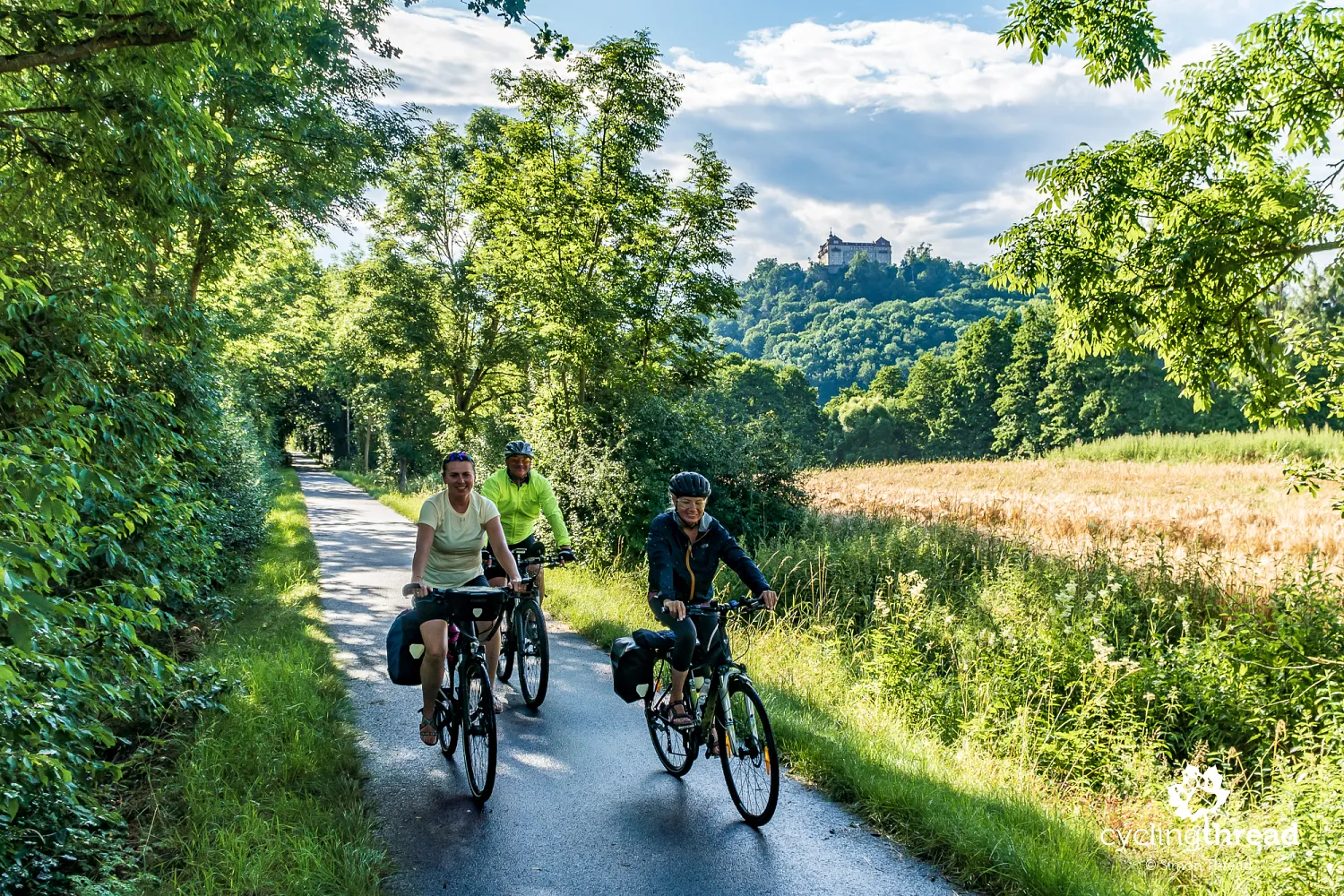
Nearly 300 kilometers of railway cycling paths
BahnRadweg Hessen, the Hesse Railway Cycle Route, is essentially a combination of several shorter routes that form a larger network. Its total length of about 270 kilometers includes six post-railway (and other) paths: the Vulkanradweg (94 kilometers), the Vogelsberger Südbahnradweg (33 kilometers), the Milseburg-Radweg (27 kilometers), the Ulsterradweg (58 kilometers), the Kegelspielradweg (27 kilometers), and the Solztalradweg (28 kilometers). In addition, approximately 40 kilometers of the Ulsterradweg overlap with the European long-distance route EuroVelo 13, known as the Iron Curtain Trail. The overall scheme also incorporates about 50 kilometers of the river route Fulda-Radweg. The layout of the entire railway-based route can be viewed on the interactive map linked from the route’s official website.
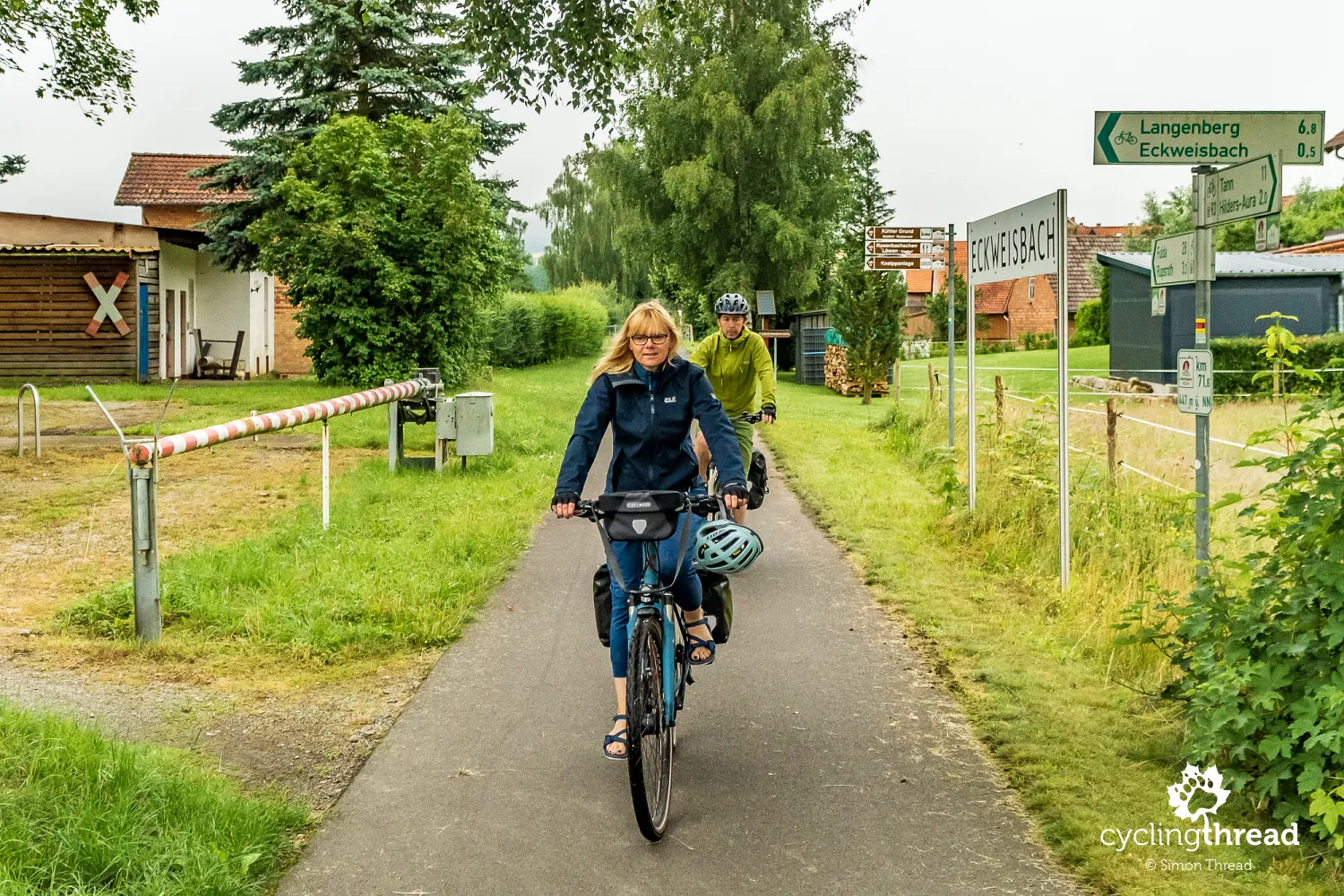
Scenic views shaped by Vogelsberg and Rhön
Geographically, cyclists exploring the post-railway paths in Hesse travel through two gently rolling mountain ranges - Vogelsberg and Rhön - separated by the wide Fulda River valley. From a broader perspective, Vogelsberg and Rhön are part of the Hessian Highlands, themselves a section of the larger German Central Uplands that stretch east to west across the country. These two ranges provide the pleasing scenery for the ride, even though their highest peaks don’t surpass 1,000 meters above sea level. The entire area through which the Hesse Railway Cycle Route runs is easy to locate on a map of Germany - it lies northwest of Frankfurt am Main, between Hanau, Fulda and Bad Hersfeld.
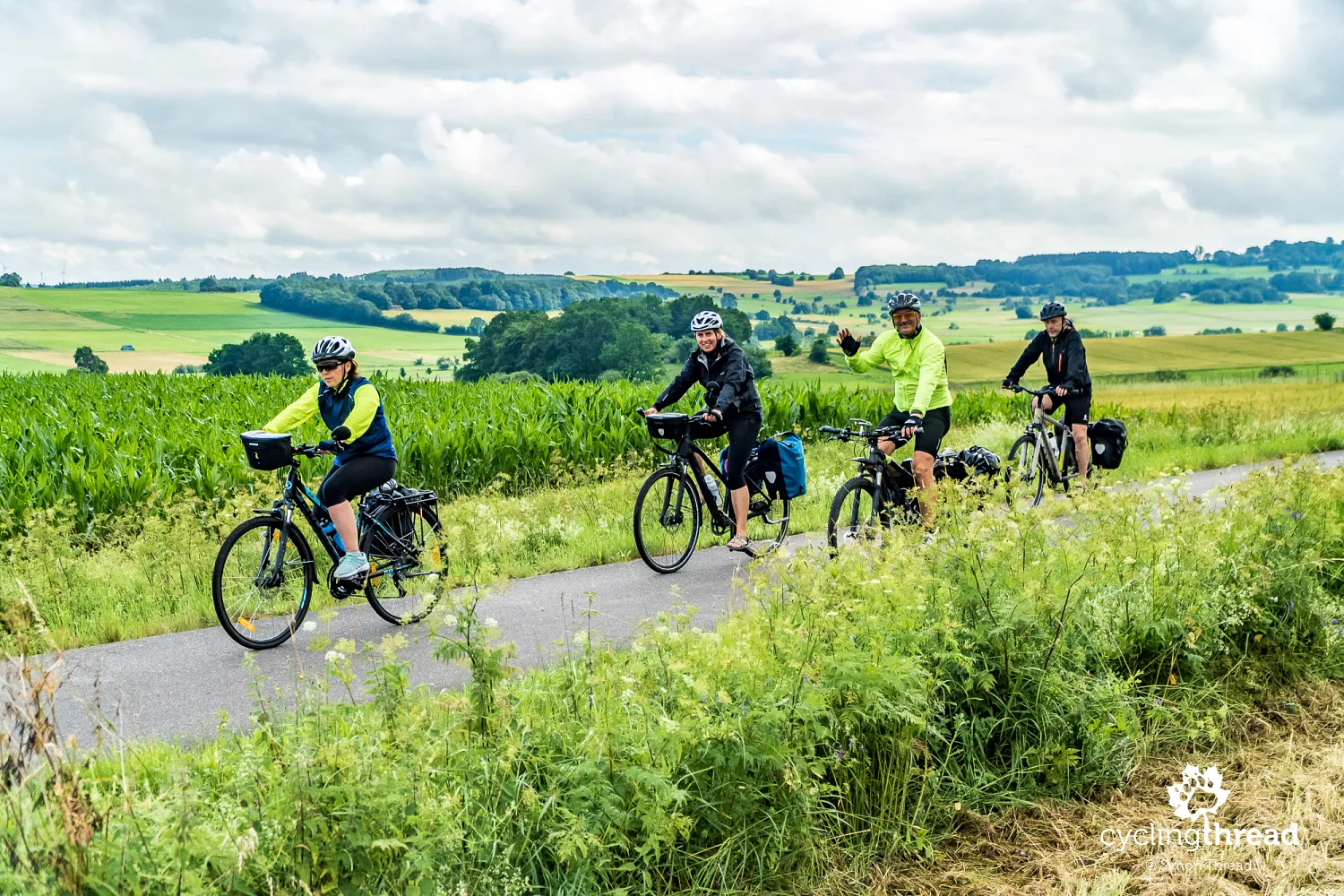
Vogelsberg and Rhön are volcanic in origin, making them the largest post-volcanic landscape in Central Europe. Around 15 million years ago, active volcanoes dotted the area, creating an atmosphere far removed from today’s idyllic German countryside. Over millions of years, the terrain softened, but the silhouettes of ancient volcanoes remain distinctly visible. Many of them can be seen from the Vulkanradweg - the first segment of the Hesse Railway Cycle Route. In the Vogelsberg Geopark, established to preserve and promote the area’s geological heritage, there are around 50 geosites showcasing evidence of past volcanic activity. Among them are striking basalt columns, typically five- or six-sided, rising from old lava chimneys.
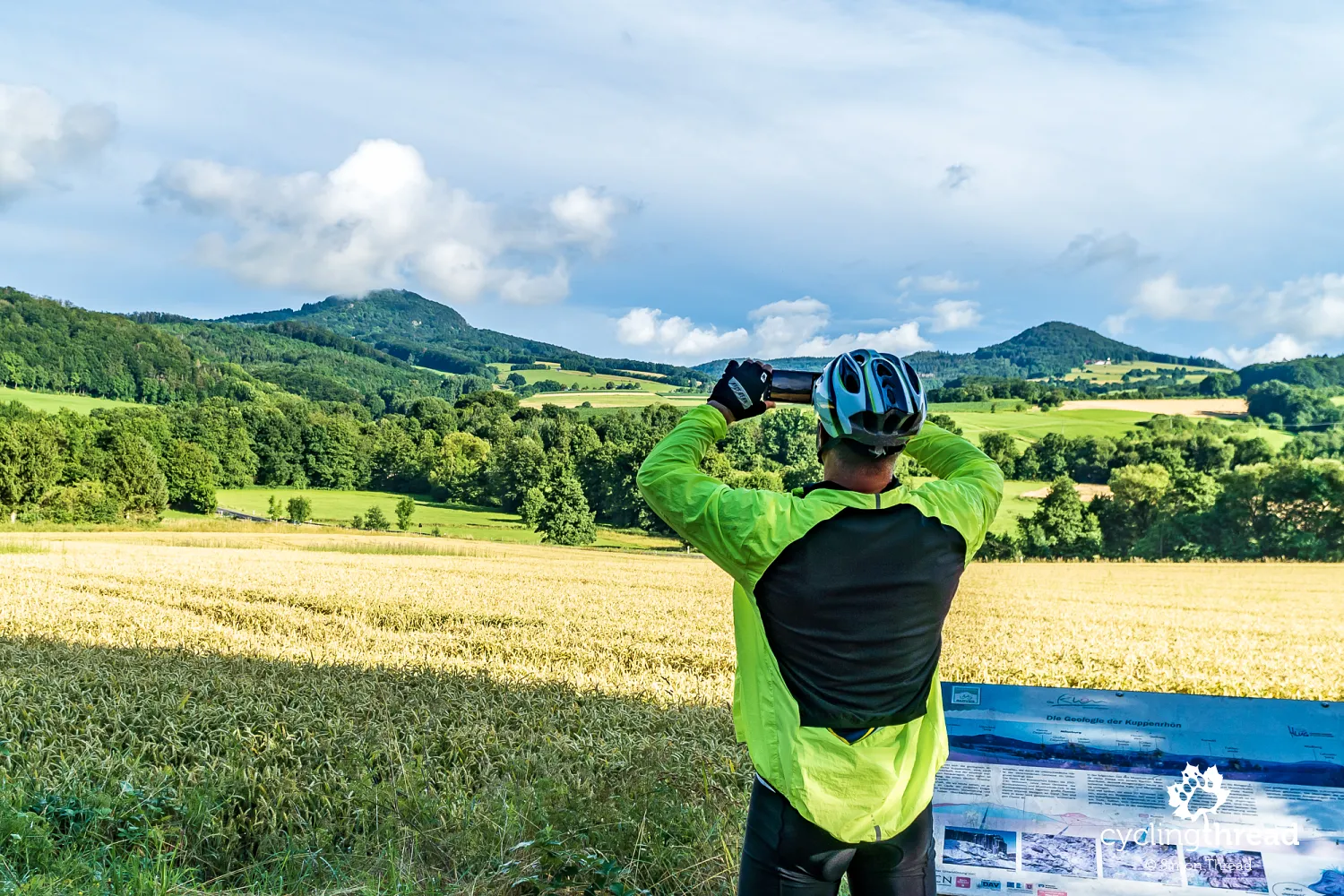
The railway Vulkanradweg: the route’s starting point
Our three-day adventure along the BahnRadweg Hessen began in the town of Altenstadt, where the Vulkanradweg starts. This nearly 100-kilometer railway bike path follows the route of the former Oberwaldbahn. The Oberwaldbahn (Upper Forest Railway), initially known as the Vogelsbergbahn, was constructed over nearly two decades around the turn of the 20th century. The final, most challenging segment crossing the highest parts of the Vogelsberg was completed only in 1906. However, due to competition from increasingly popular bus services after World War II and a shift in Hesse’s population closer to Frankfurt, passenger numbers on the Oberwaldbahn began to decline in the 1960s. Operations were suspended in 1975, and the railway was officially closed in 1994. A few years later, work began on the cycle path, which was completed in stages between 2000 and 2008.
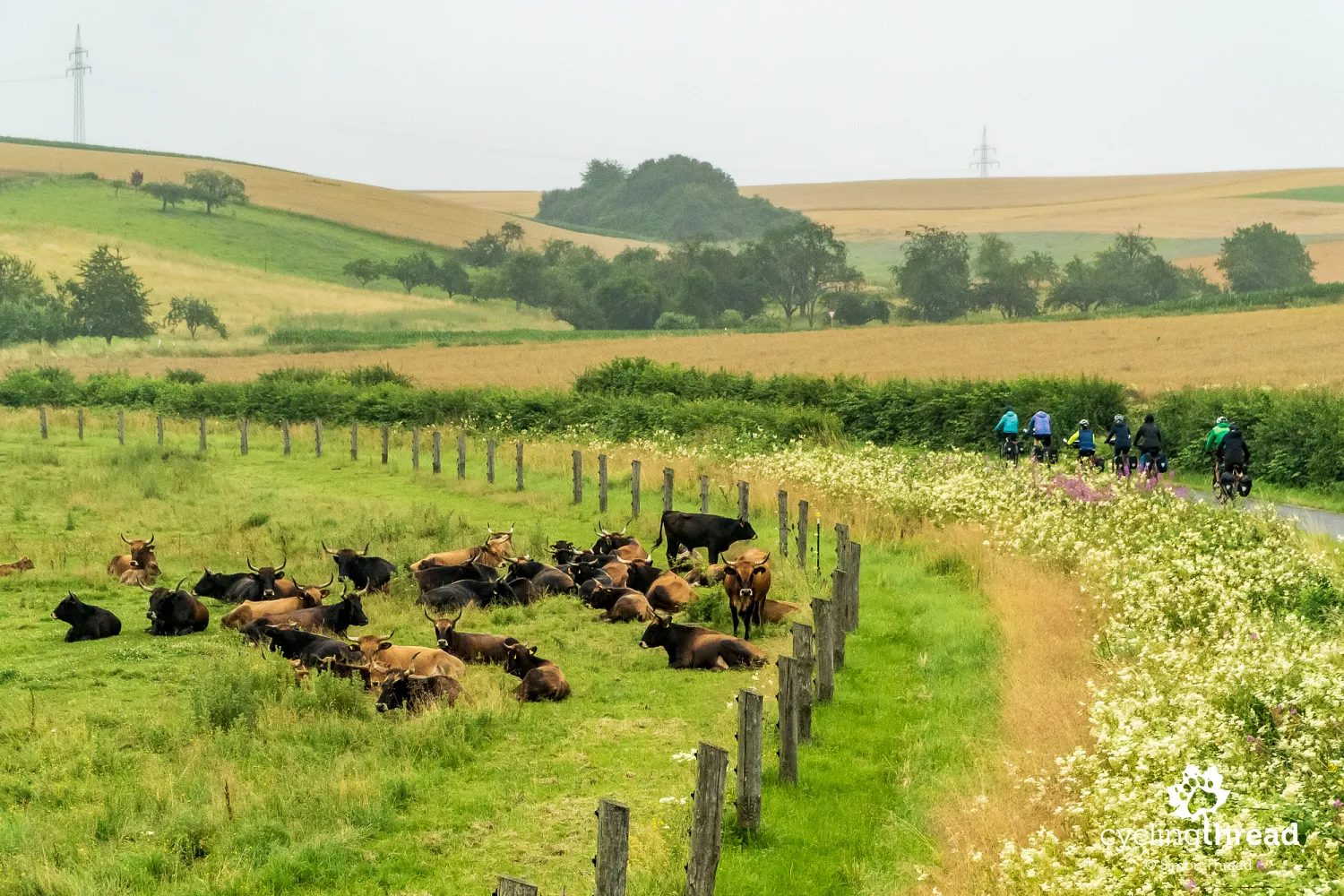
Over steep, wet cobblestones in Ortenberg
After several kilometers, the Vulkanradweg signs led us across an old stone bridge to the small town of Ortenberg. From the bike route, we began climbing the rain-soaked cobblestone streets, laboriously pushing our bikes. Passing the charming Gothic town hall, which initially served as a department store, and crossing the sloped market square with its fountain, surrounded by well-kept half-timbered façades, we eventually reached St. Mary’s Church. The main nave of the church is crowned with a replica of the 15th-century Altenberg Altarpiece, the town’s most prized artwork. On the way back, we also walked our bikes, cautious of the slippery Hessian cobblestones.
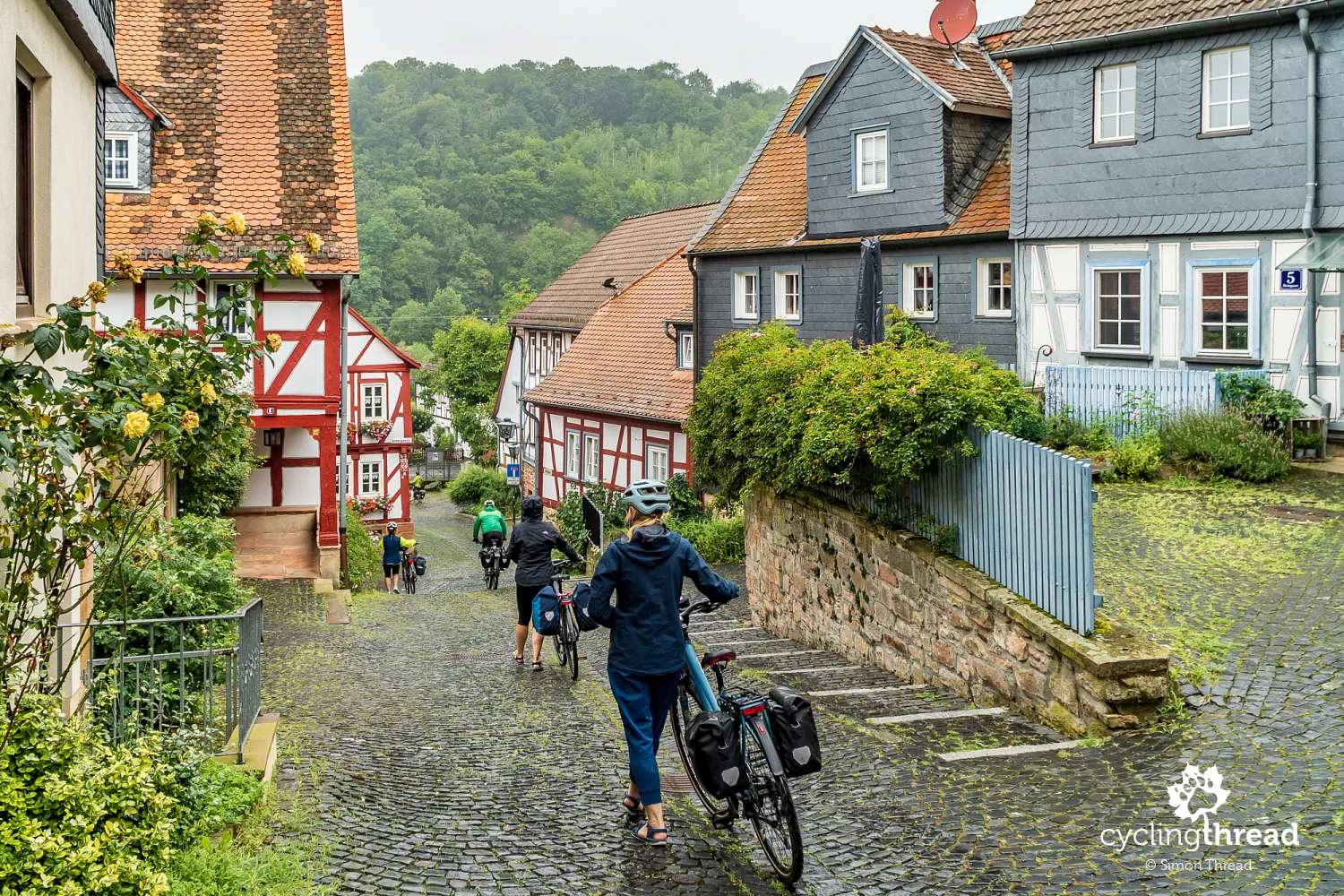
25 kilometers of climbing through volcanic Vogelsberg
Beyond Ortenberg, the road began to rise - a continuous 25-kilometer climb to the village of Hartmannshain at the highest point of Vogelsberg and our route. The ascent ends with the silhouette of the historic Hartmannshain bridge. A few years ago, local authorities planned its demolition, but in 2017, village residents successfully protested, saving the bridge. During our visit, the bridge was covered in scaffolding as restoration work was ongoing. Nearby are the buildings of the former Hartmannshain aircraft munitions factory, later repurposed by NATO forces after the war, and one of the first wind farms in the region’s mountains, clearly visible from the bike route.
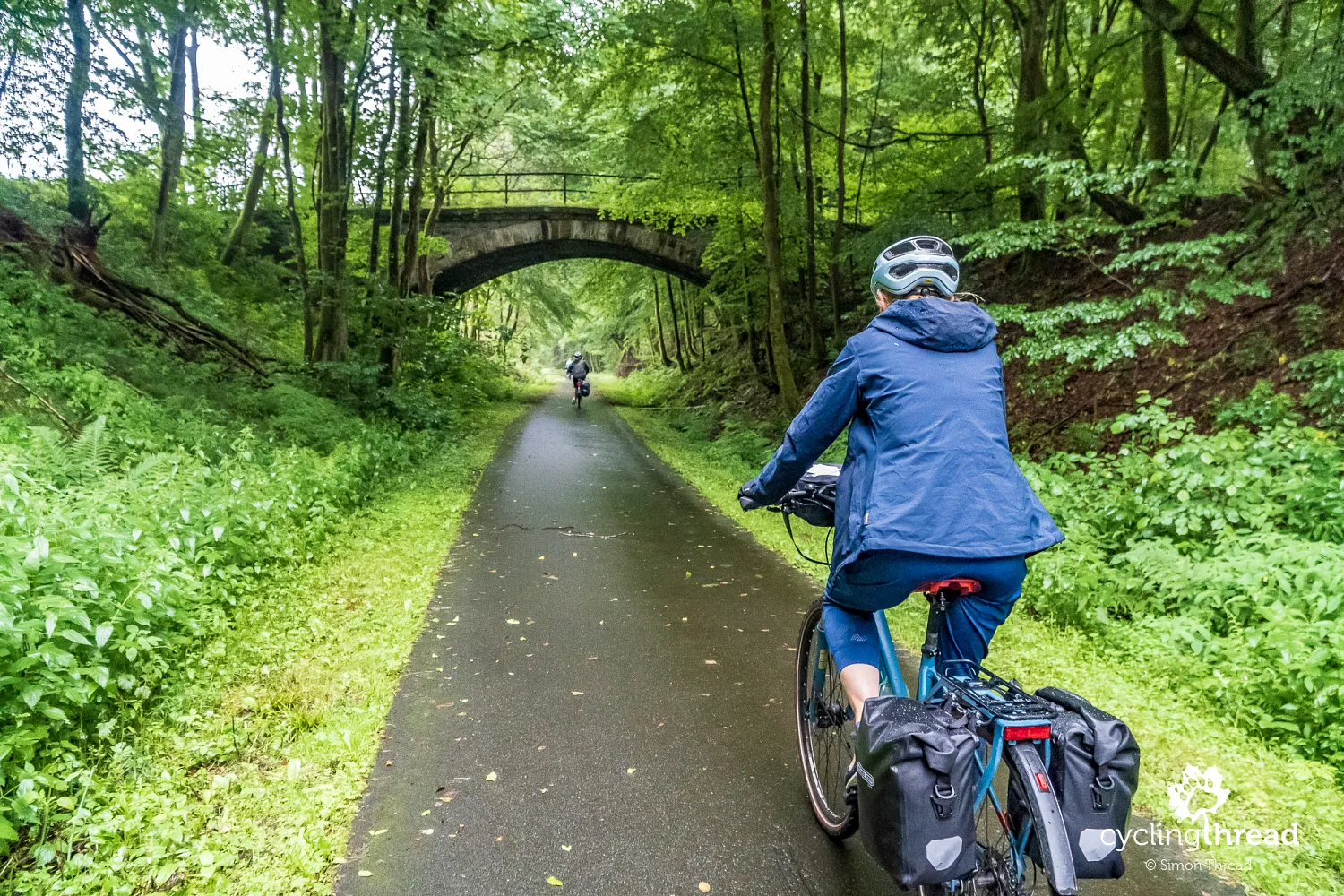
No bad weather, just...
…poor clothing choices, as the old outdoor saying goes. On this rainy day, we were living proof of that wisdom. All eight of us cheerfully pedaled toward the summit near Hartmannshain. Instead of suffering through alternating rain and drizzle, we seemed unaffected - perhaps even enjoying it at times. Each of us had our own strategy for staying dry, from lightweight Gore-Tex Paclite rain jackets to practical rain ponchos - all available at our trusted Bike Center’s “rain jackets” section.
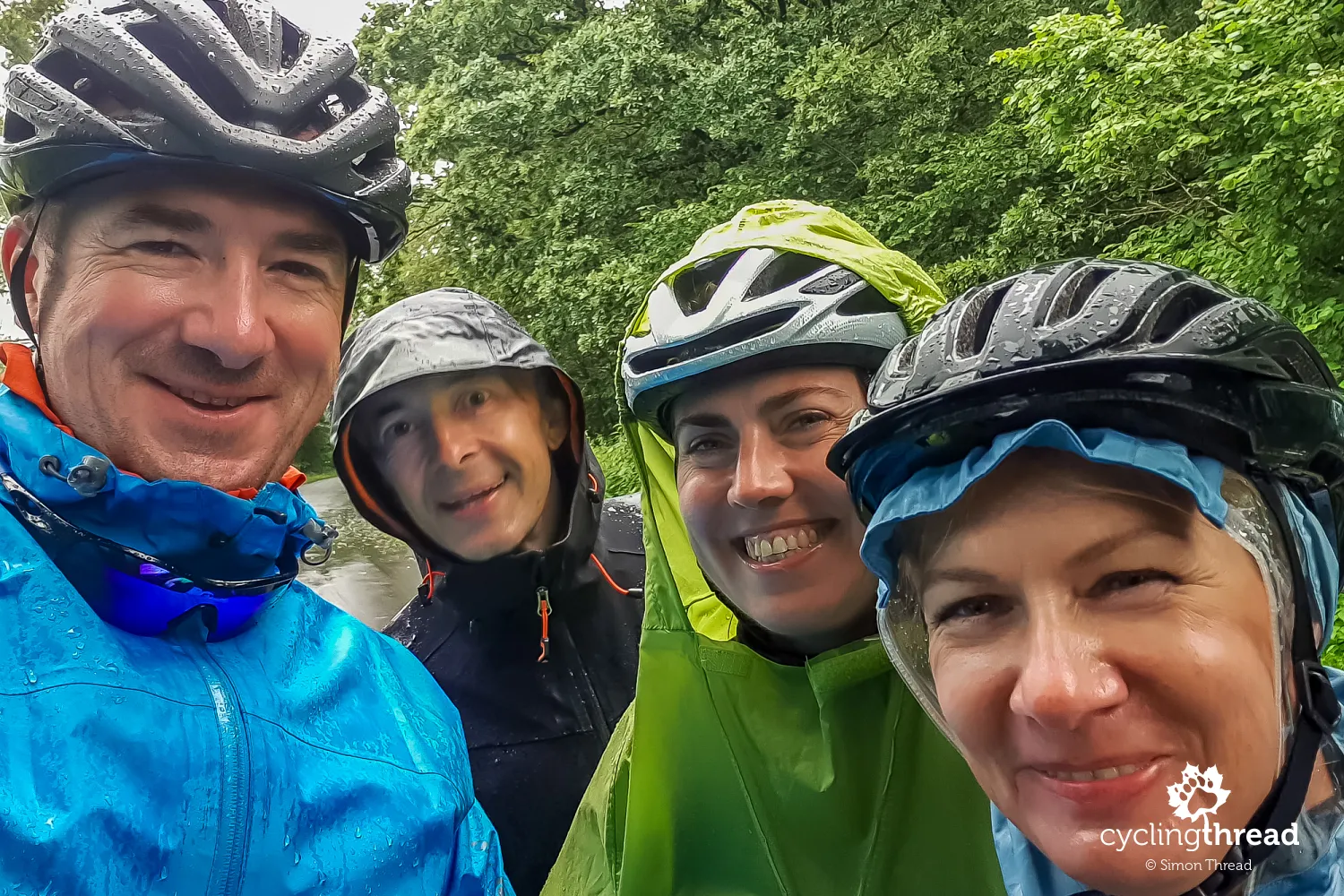
During the climb, we sought shelter from the rain in a roadside rest stop, where I was met with a delightful surprise. Hot roast chickens, crusty rolls, and mini bottles of champagne appeared on the table - our team’s toast to my birthday. I was so touched that I didn’t take a single picture, so let this photo of Paweł preparing for the birthday lunch remind us of the moment. Thank you so much, team - you’re fantastic! A great cycling crew is a treasure.
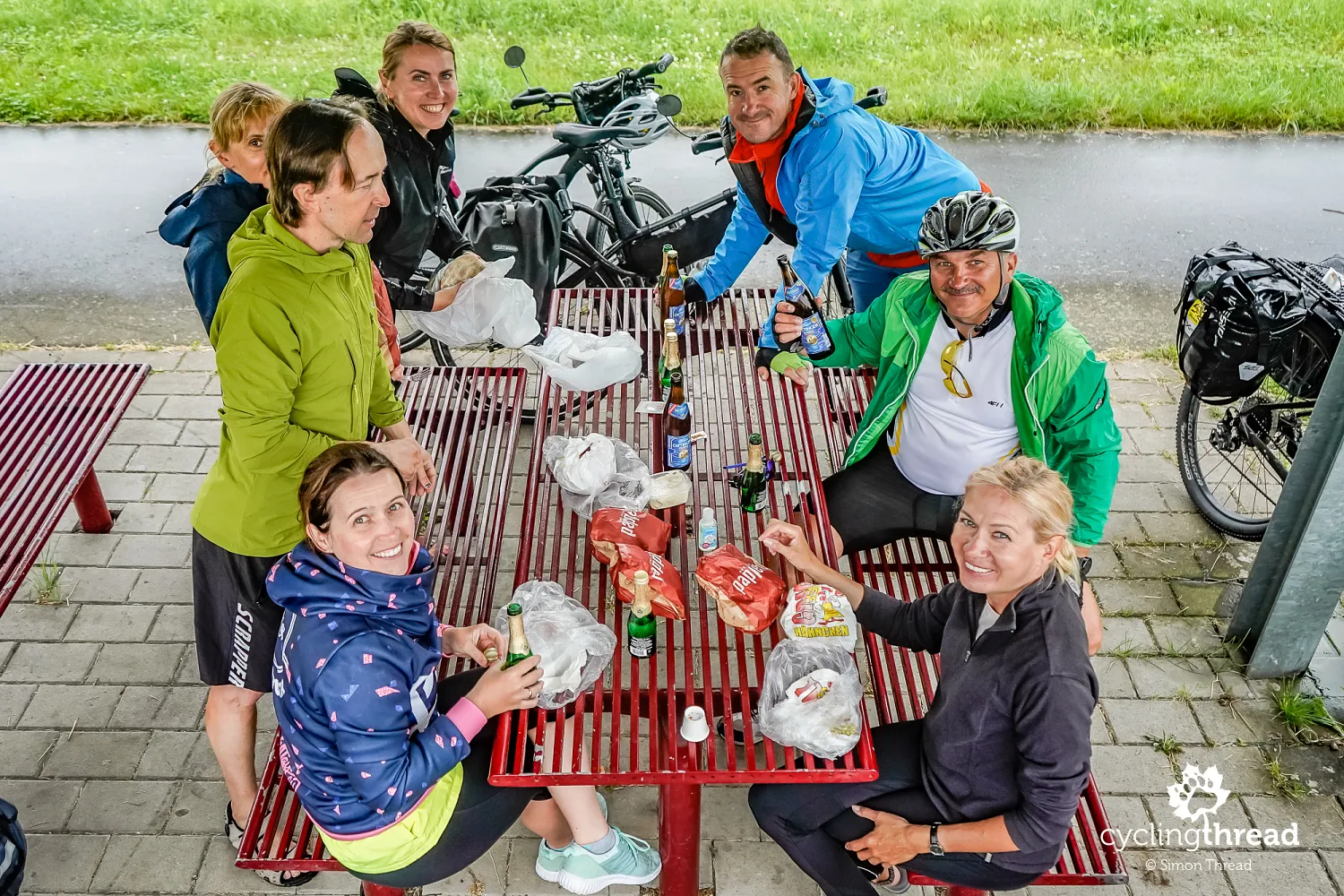
Hessian Tuscany along the bike route
As we descended from Hartmannshain, the weather began to clear. Forested sections gave way to open landscapes, and Vogelsberg finally revealed its most beautiful side. The sweeping views of the neighboring ridges quickly reminded us why the Wetterau district is fondly called “Hessian Tuscany.” The comparison isn’t just about the natural scenery, the neatly arranged fields, or the tree-lined roads - it’s also about the picturesque panoramas of Hessian towns. Perhaps if I had taken the photo below at a different time of year and in better weather, the hilltop village of Herbstein could have easily passed for one of Tuscany’s Italian gems.
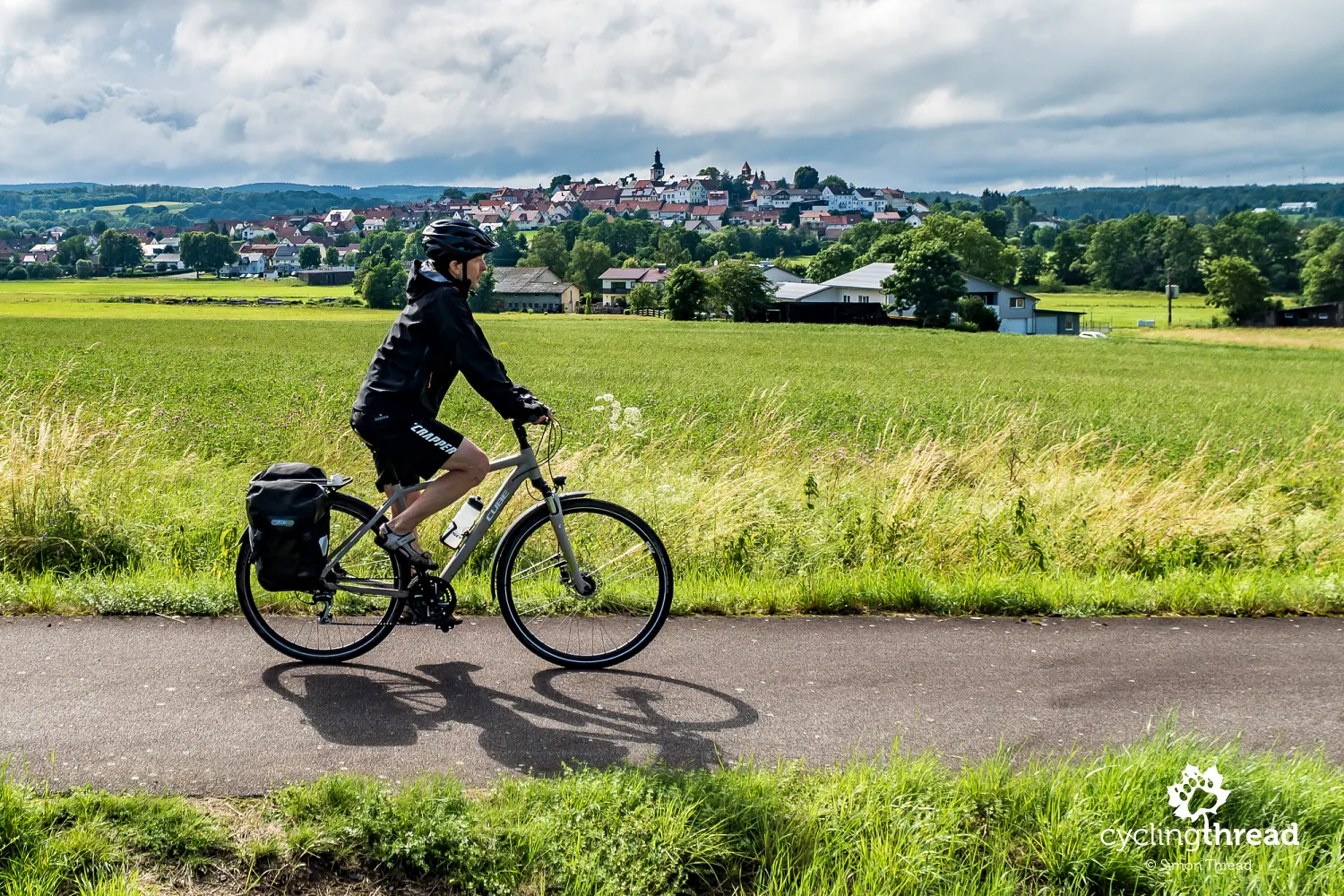
The only tourists among half-timbered houses in Lauterbach
As we strolled through the streets of Lauterbach, our destination on the first day, it was clear that we were the only tourists in town. A few locals hurried along empty streets, restaurants closed earlier than usual, and some museum facilities remained shut. Everything suggested that towns like this, which can’t attract tourists with major, well-known attractions, will take a long time to recover from the pandemic downturn. We had similar impressions while cycling the Hohenzollern Route in Franconia earlier. These concerns seem to be shared by local hoteliers and owners of small lodging establishments, which are now notably fewer in online booking platforms. I suspect that the costs of keeping such places operational outweigh the revenue from the few tourists using them, leading to the closure of guesthouses and hotels.
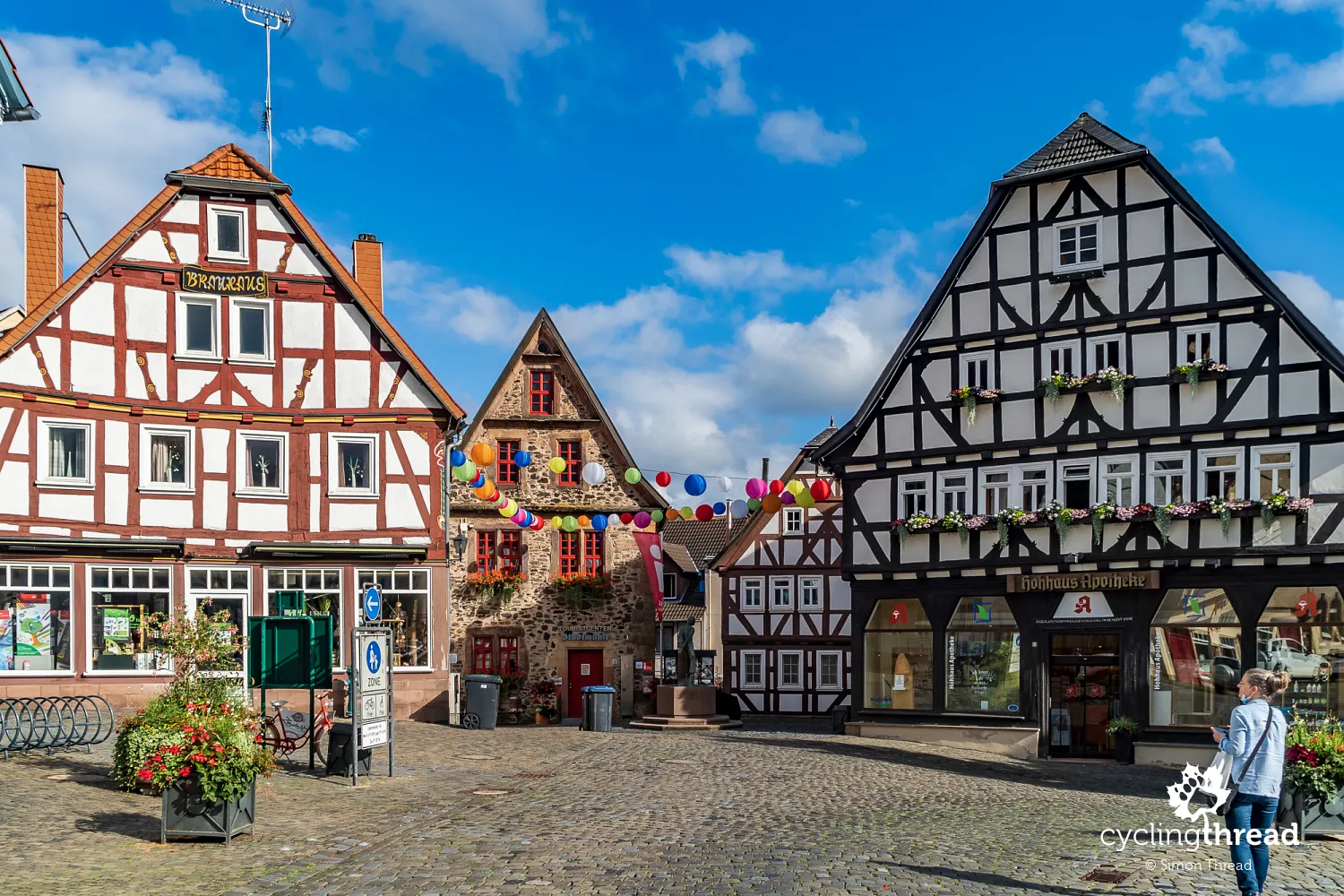
Lauterbach was probably the third most interesting town on our route, after Schlitz and Fulda. Along with Schlitz and Bad Hersfeld, it belongs to the Fachwerkstraße, the German Half-Timbered Route, which runs through many "checkered" regions across the country. Beautifully maintained half-timbered façades dominate the pleasant, though quiet, town center, with documented history dating back to the 8th century. Beyond the historic houses, Lauterbach features at least two impressive structures worth visiting. The first is the Hohhaus, a Parisian-style palace made of yellow sandstone located at the end of the narrow market square. The second is Lauterbach Castle, also situated in the town center. Both can be visited during designated hours.
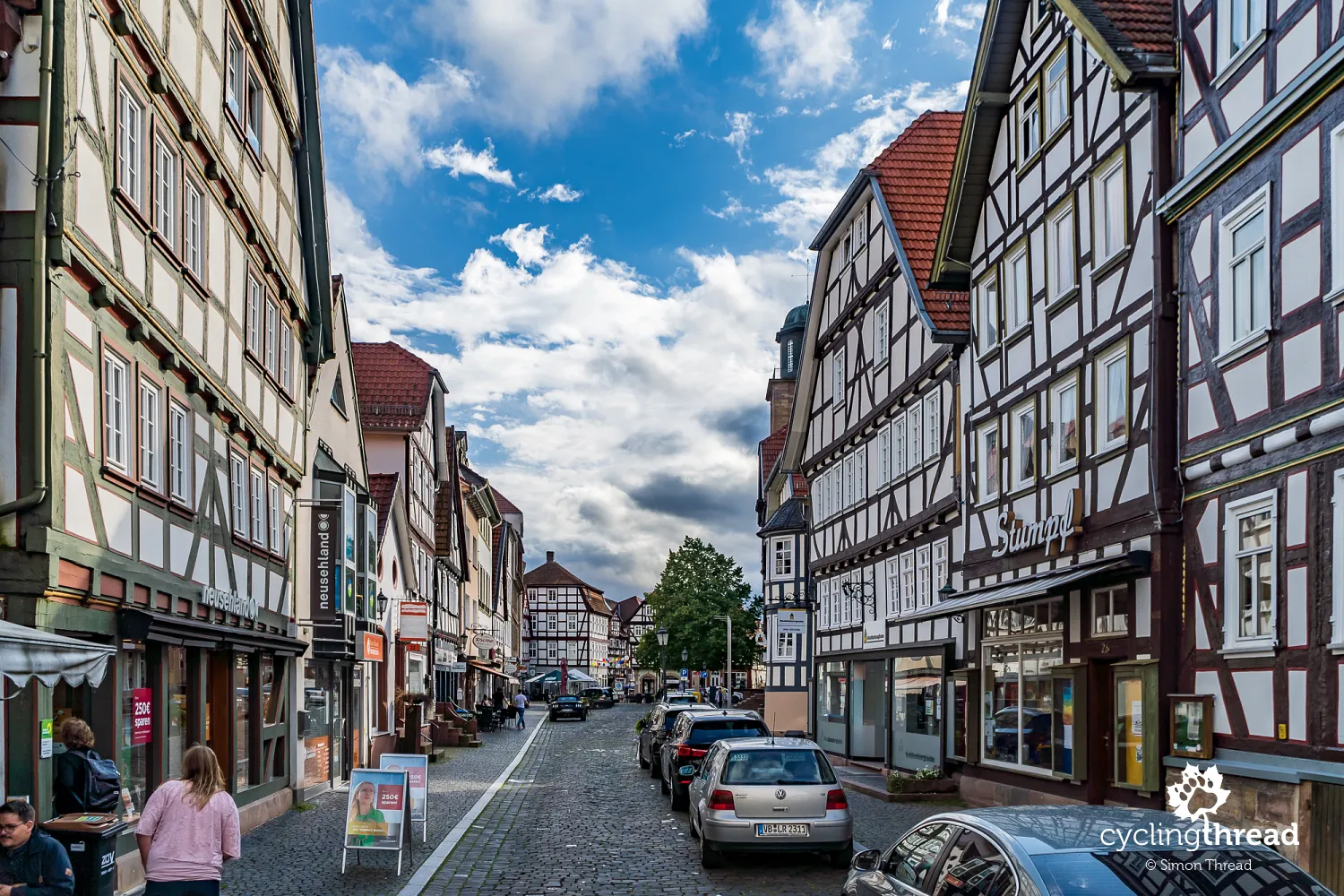
German castles and palaces in Hesse
Writing about Lauterbach, I should also mention Eisenbach Castle, located a few kilometers outside the town. Known as the "Wartburg of Hesse," its nickname refers not to architectural similarities but to the role it played during the Lutheran Reformation. Unfortunately, like many castles and palaces in Germany, it is privately owned and can only be viewed from the outside. Another impressive palace we passed during our journey through Hesse was Bieberstein Palace, located east of Fulda. Perched on a high hill above a post-railway bike route that zigzags its way up, it remained a companion to our group for quite some time.
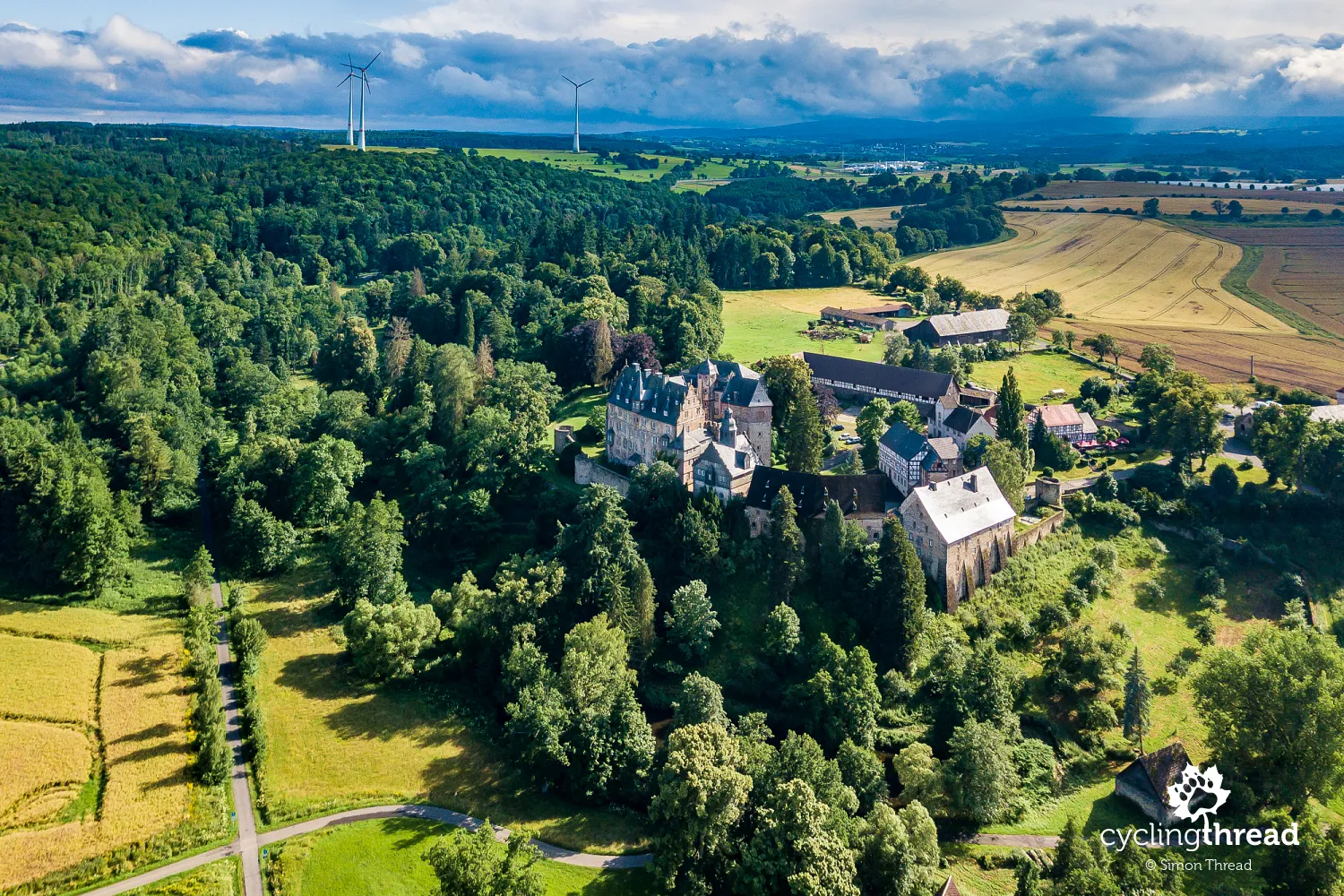
In Schlitz, the world’s largest candle shines
The most beautiful and enjoyable town on our short trip along the Hesse Railway Cycle Route was Schlitz, known as the “town of five castles.” The nickname is no exaggeration - within the small historic center, there are indeed five castle-like or fortified palace structures. Even those unfamiliar with Schlitz’s topography should be able to spot all five in the photo below. But Schlitz offers something even more unique - the world’s largest candle! During Advent, the tallest tower, also visible in the photo, is entirely wrapped in red fabric, with a glowing installation at its top resembling a flickering flame. It looks spectacular after dark, and it’s hard to believe that despite this candle “burning” every Advent for 30 years, I had never heard of it before.
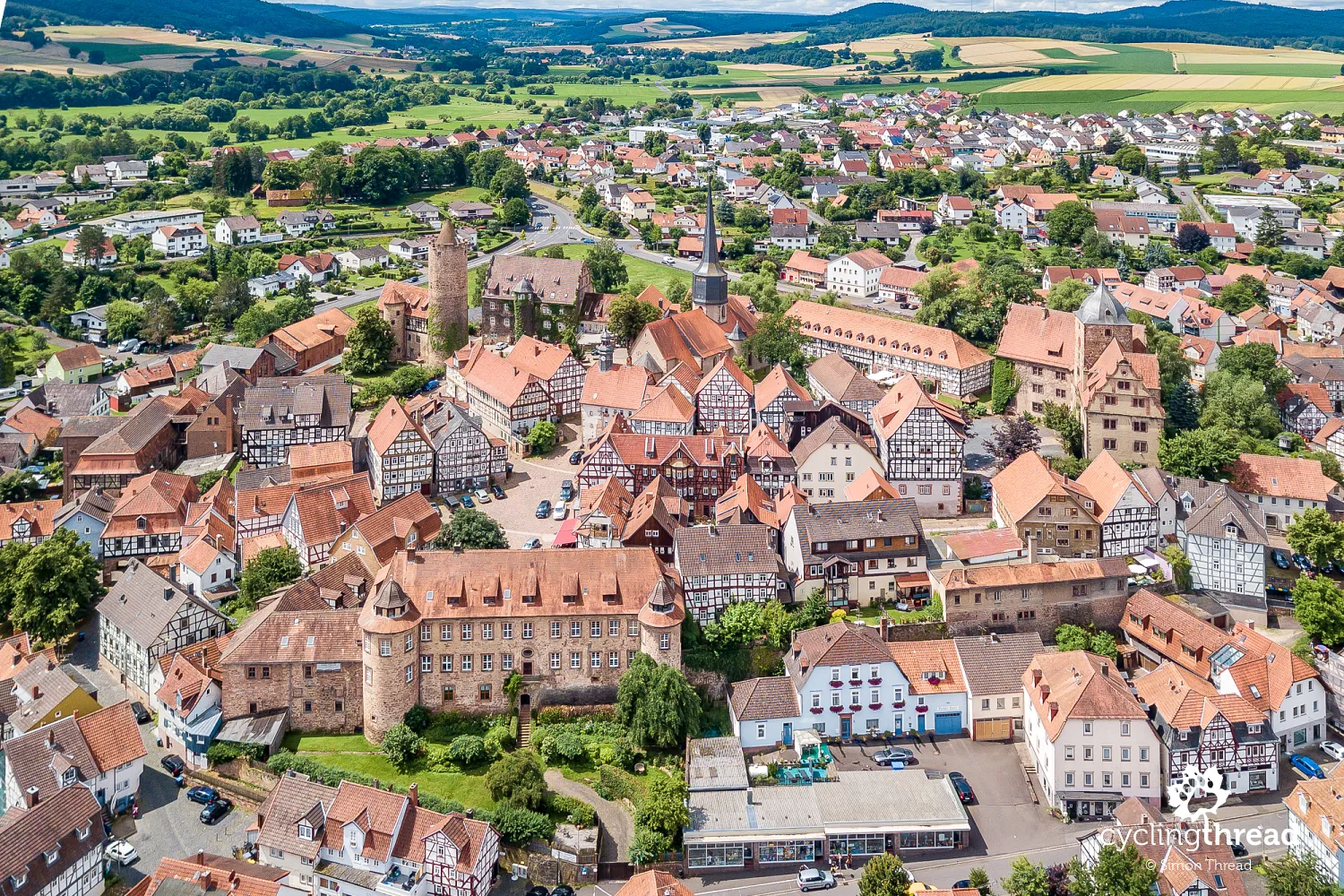
Schlitz is impressively picturesque, both from the bike route and through the lens of a drone, and its preserved buildings and unconventional layout of the historic town center are equally captivating up close. We stopped for a short break at a restaurant overlooking the sloped market square, where we could admire the unique square with its historic St. George’s fountain in the center. By the way, could the numerous cars we saw parked in the square support the idea that Schlitz doesn’t prioritize its tourist image? Perhaps so few tourists visit that Schlitz still puts residents’ convenience first. And let me be clear - these musings aren’t meant as criticism.
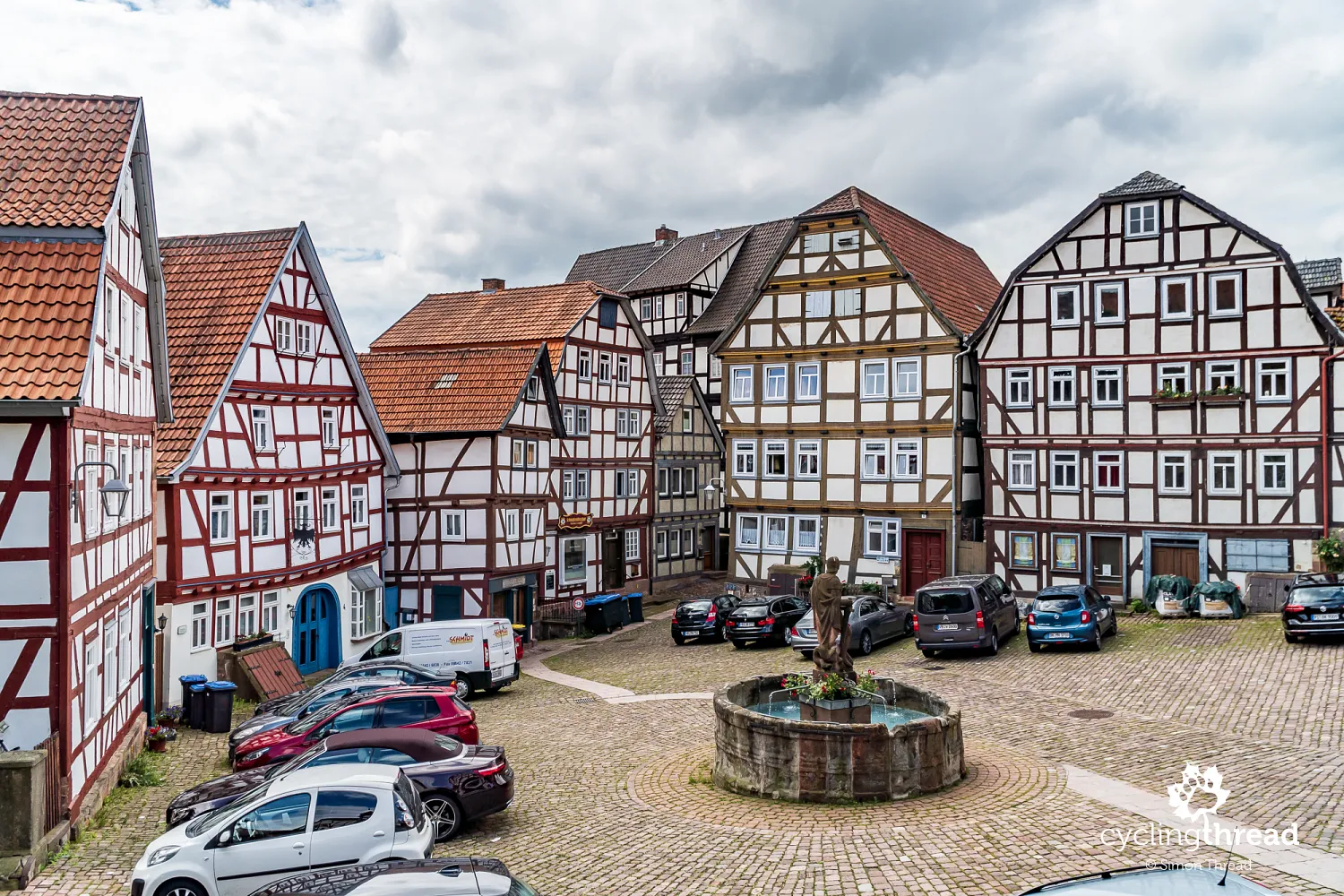
A stretch along the Fulda river cycling route
Perfect weather, excellent cycling paths, and green surroundings accompanied the next section of our journey. Beyond Schlitz, we left the post-railway routes for more than 20 kilometers and followed the Fulda-Radweg - a riverside cycling route along the Fulda River - toward Fulda. The gentle, long, and mostly straight stretches of former railway lines were replaced by much more varied paths, often passing through Hessian villages. The atmosphere became more rural, the route more engaging, yet the cycling comfort remained high. On this stretch, we encountered the most cyclists, confirming that riverside cycling routes are incredibly popular in Germany. It’s worth noting that the Fulda River flows into the Weser River, alongside which runs the Weser Cycle Route - the second most popular cycling route in Germany, after the Elbe.
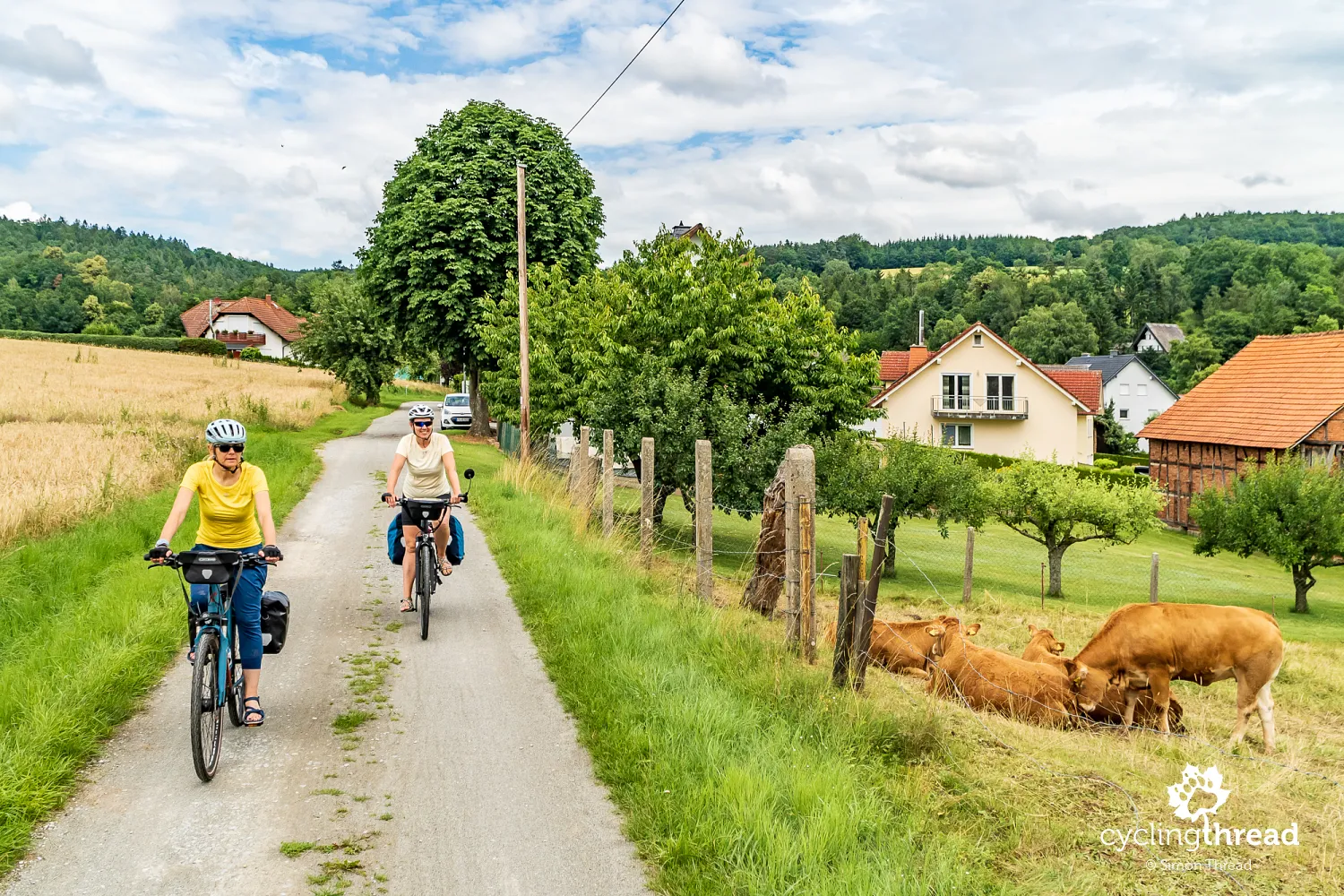
Approached by a friendly teacher in Fulda
Fulda will likely be remembered most for the friendly German teacher who spontaneously approached our rather noisy group while we were waiting for our meals in a restaurant garden. She quickly shared her surprise at encountering such a large group of cyclists in these unusual times. She confirmed that there were far fewer tourists and that Germans were worried about the future of the tourism sector. Once again, our feeling was validated - we were among those paving the way, blazing trails after the pandemic slump that hit the tourism industry. And we didn’t feel bad about it at all. All eight of us were fully vaccinated well in advance, which allowed us to feel relatively safe cycling through Germany.
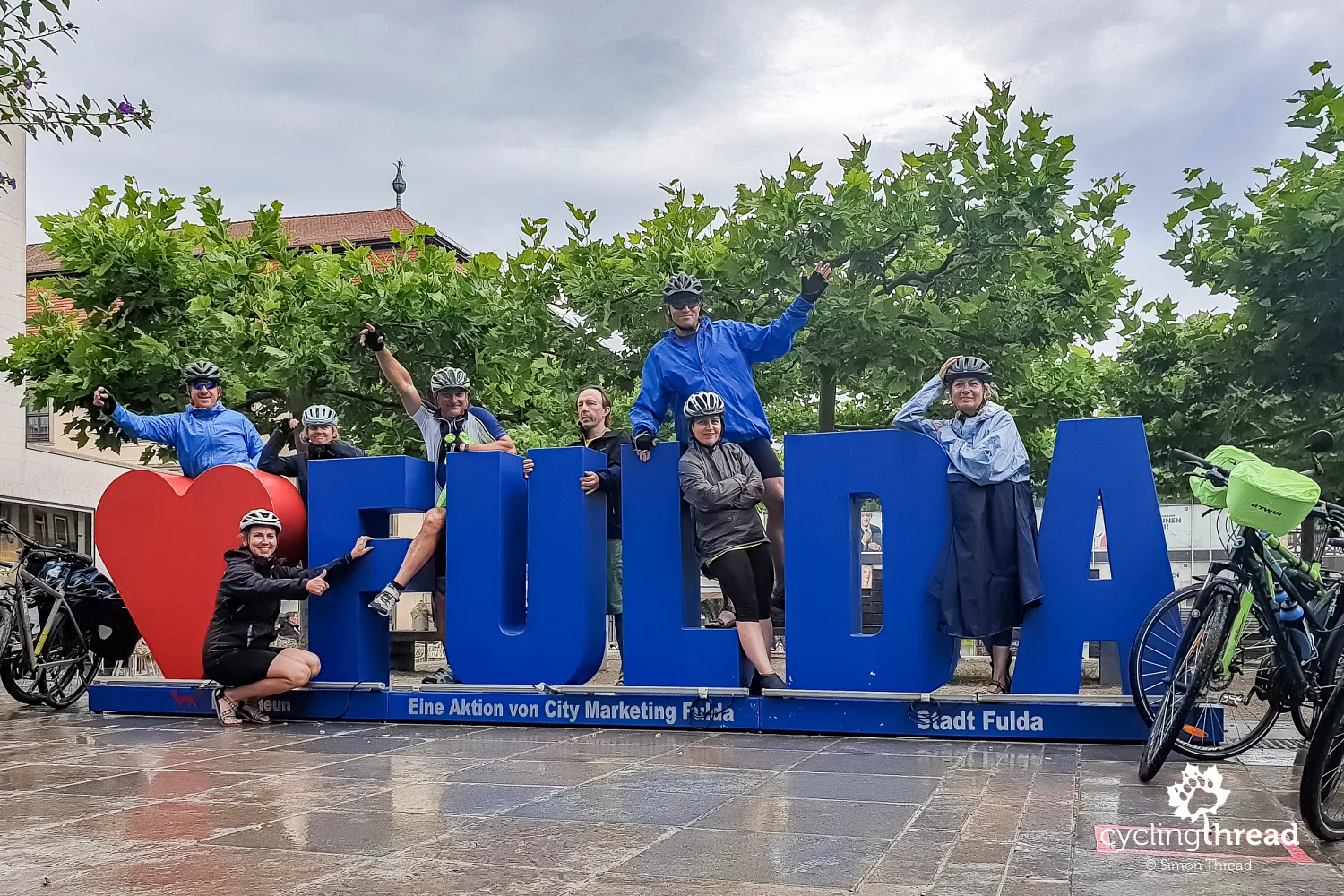
Car tires next to the relics of Germany's patron saint
For most Poles, Fulda might only be associated with a brand of car tires, but the city itself boasts a history over 200 years older than Gdańsk. As early as 744, a Benedictine abbey was established in Fulda by Saint Boniface, the patron saint of Germany. His relics are housed in the Cathedral of St. Salvator and St. Sebastian, a stunning symbol of the city. Nearby stands St. Michael’s Church, one of the oldest surviving churches in Germany, dating back to the 9th century. The Old Town Hall and the ensemble of the city palace are also worth a visit.
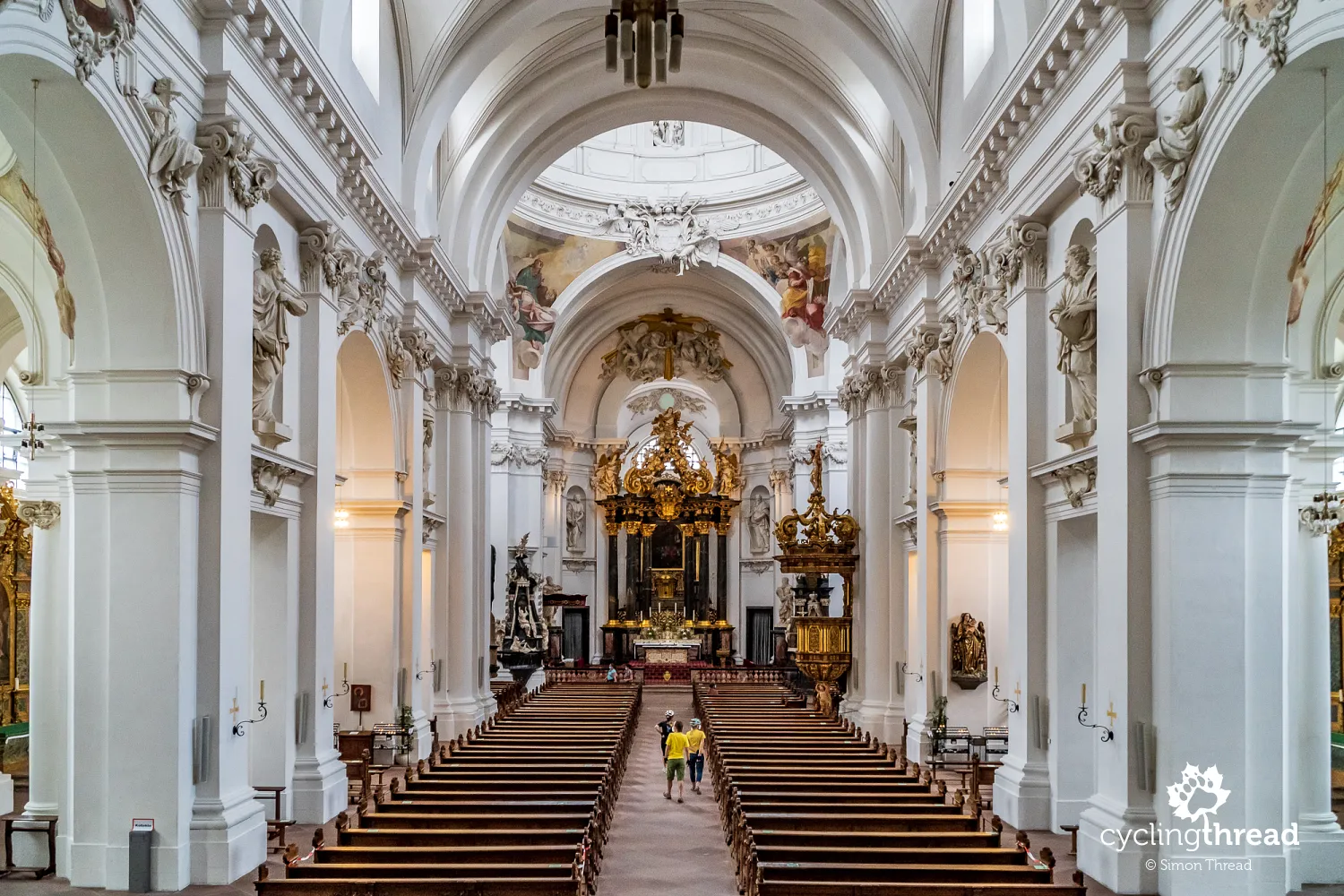
We’ll clear the way for you, dear cyclist…
A remarkable scene, speaking volumes about German cycling tourism, unfolded a few kilometers past Fulda. As we entered the Milseburg-Radweg cycling route, we spotted something unexpected in the distance: a vehicle moving toward us on the bike path. It turned out to be a tractor with a large brush, used for cleaning the surface of the cycling route. Heavy rains from the period had left a layer of mud on some sections of the path, prompting an immediate response from the route’s management. Moreover, as the tractor passed us, the driver courteously moved aside twice, without expecting us to yield. Regrettably, I must admit I have yet to encounter such a situation on any other cycle route in Europe.
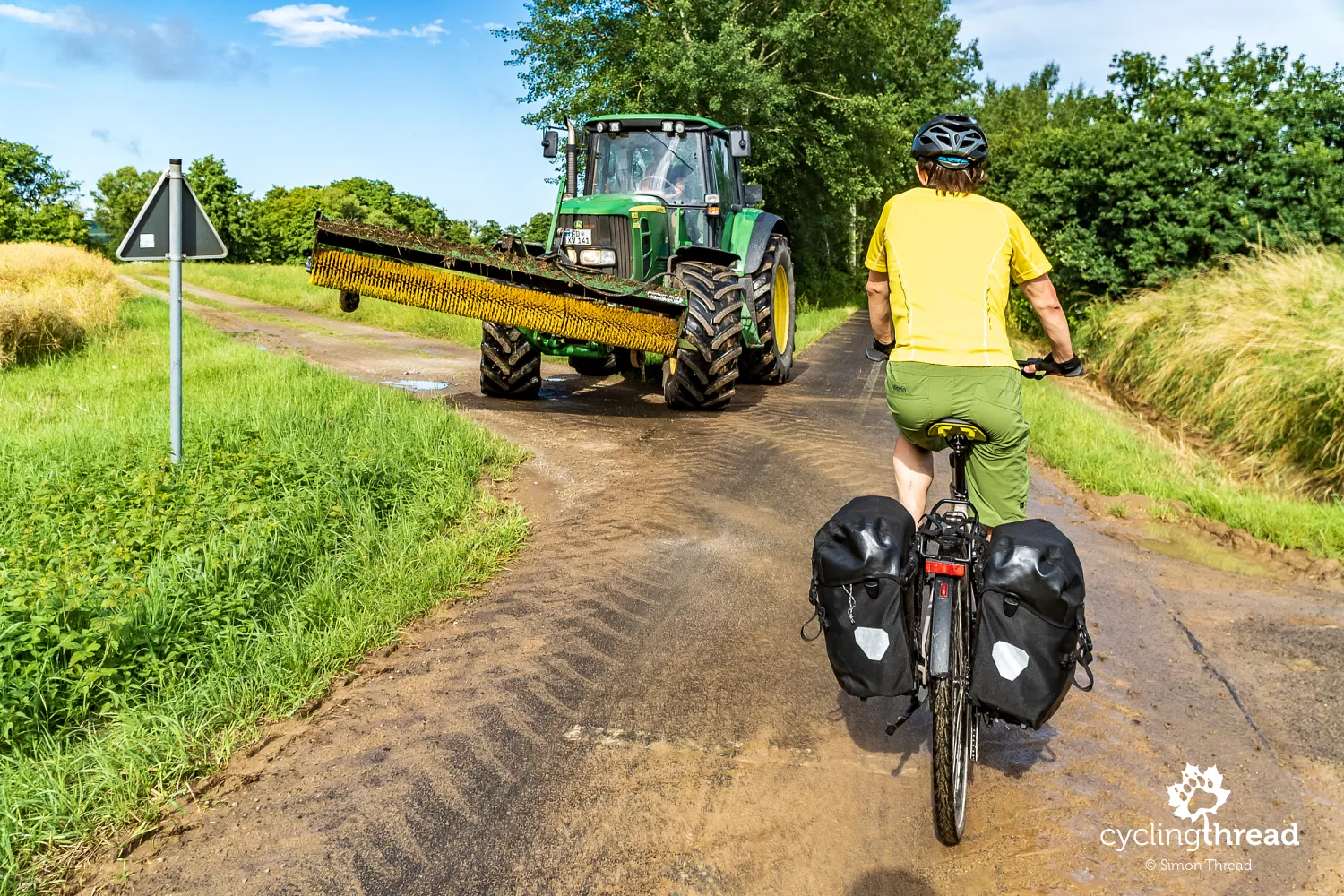
… and inform you about cycling detours
A few kilometers further, we came across another solution that remains rare on our cycling routes: a dedicated information board placed along the bike path, notifying cyclists of a closed section and directing them to a marked detour with classic yellow signs. Despite cycling thousands of kilometers on German bike routes, I’m still impressed by how cyclists are treated with the same respect as car drivers. I’m sure many of you can’t help but feel a little envious of the level of consideration German cyclists enjoy from authorities.
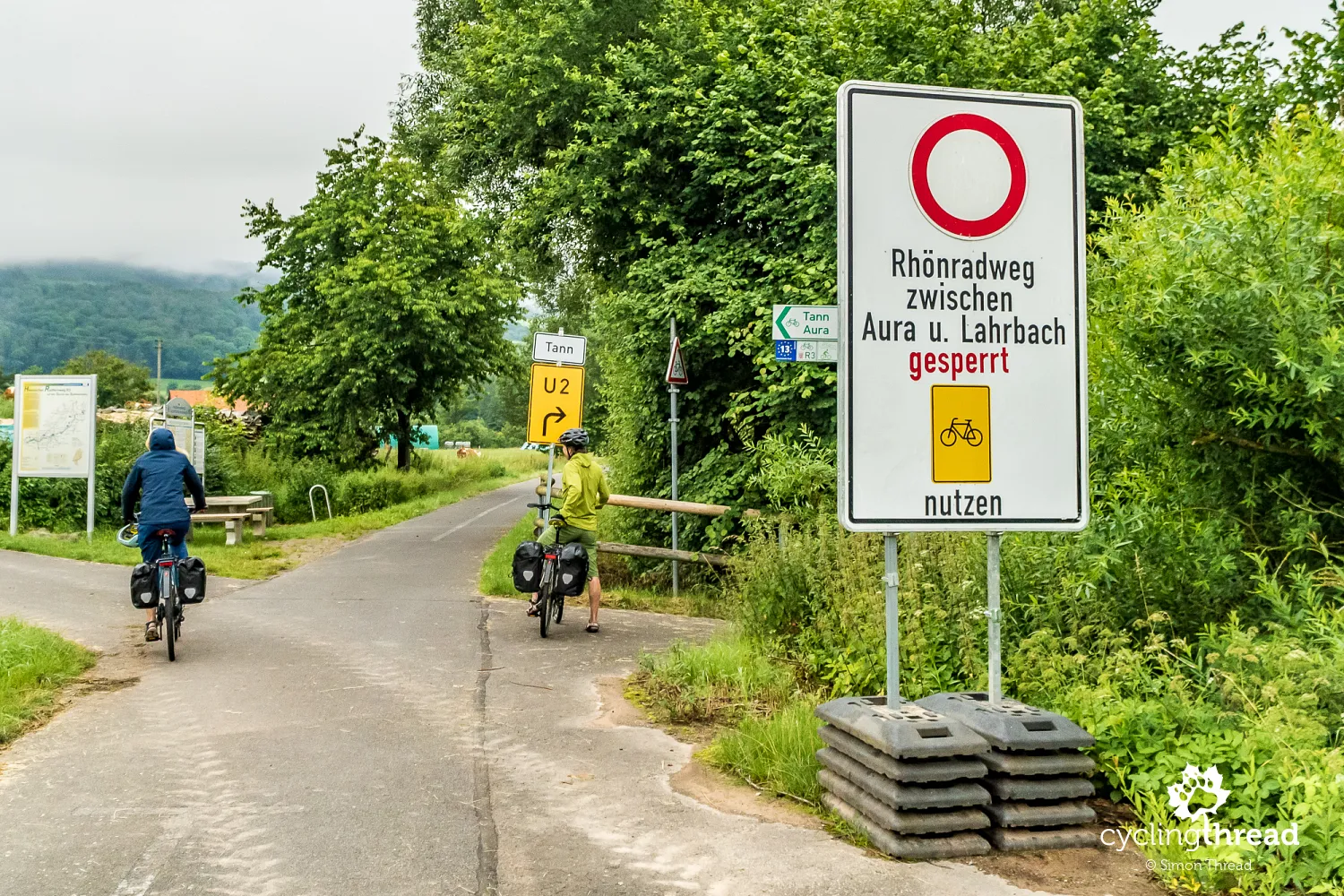
Once trains, now bikes and bats
The most striking feature of the post-railway Milseburg-Radweg, another section of the Hesse Railway Cycle Route, is the 1,172-meter-long Milseburg Tunnel. Originally used for freight transport until 1993, passenger services through the tunnel ceased as early as 1966. In March 1945, the Milseburg Tunnel served as a shelter for a train carrying German military troops led by Albert Kesselring, later sentenced to death for war crimes. Today, the tunnel is open to cyclists from April to October, while during the rest of the year, it is closed and serves as a winter refuge for bat colonies. There's no need to worry about bike lights - motion-activated lamps illuminate the tunnel, which reminded us of similar cycling routes on old railway lines we’ve explored - the famous Ciclovia Alpe-Adria, and others in Trentino and South Tyrol.
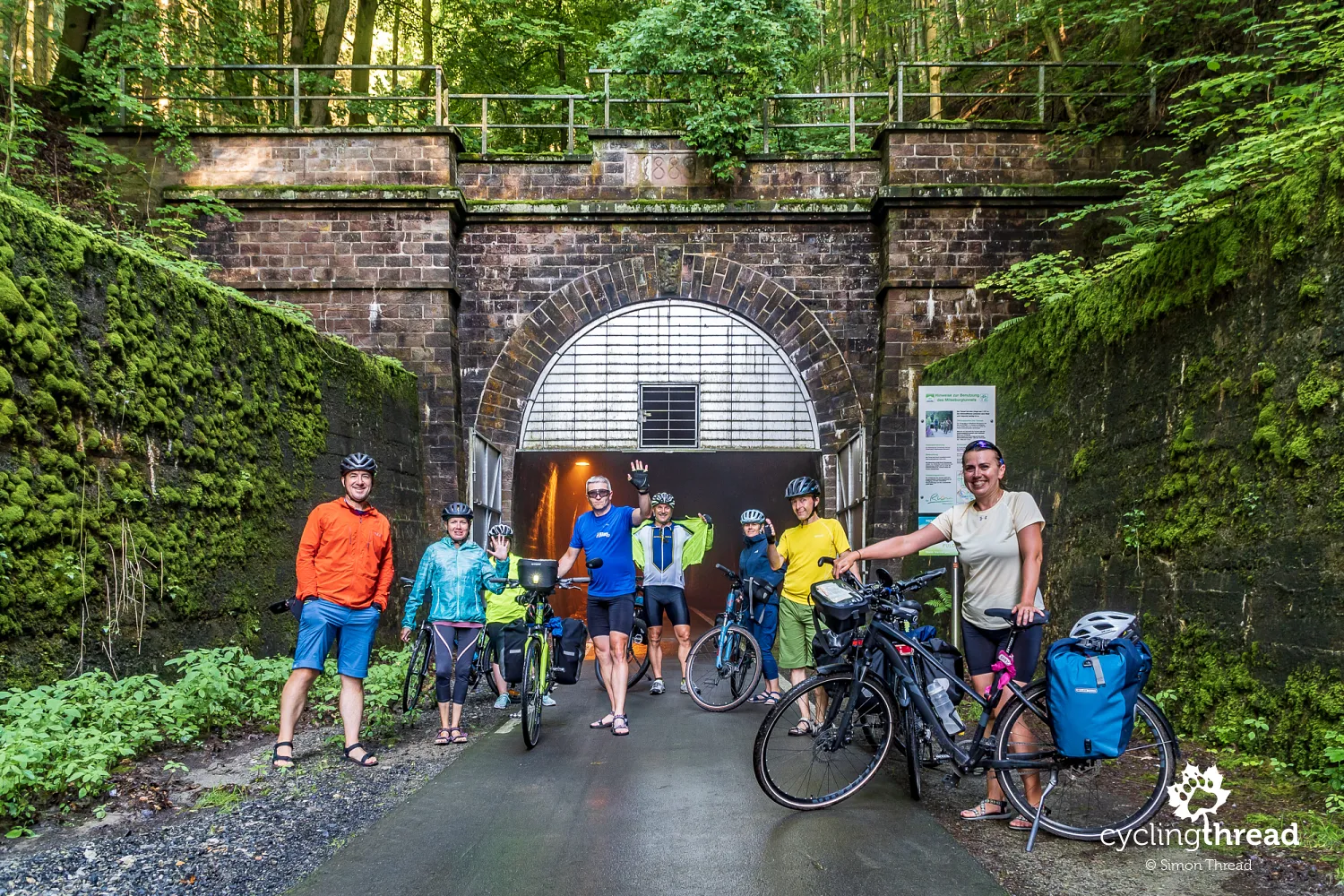
The land of extinct volcanoes in the Rhön Mountains
In this area, the landscape of Hesse once again reveals the characteristic shapes of extinct volcanoes. We had entered the Rhön Mountains, the second volcanic mountain range on our route, slightly higher than the Vogelsberg. The Rhön is a UNESCO Biosphere Reserve, aiming to protect the natural and cultural diversity of the region. The reserve also promotes sustainable development, benefiting both the environment and the local community. I firmly believe that cycling tourism aligns perfectly with these principles - it avoids many of the negative aspects of modern tourism while fostering positive ones valued by local residents.
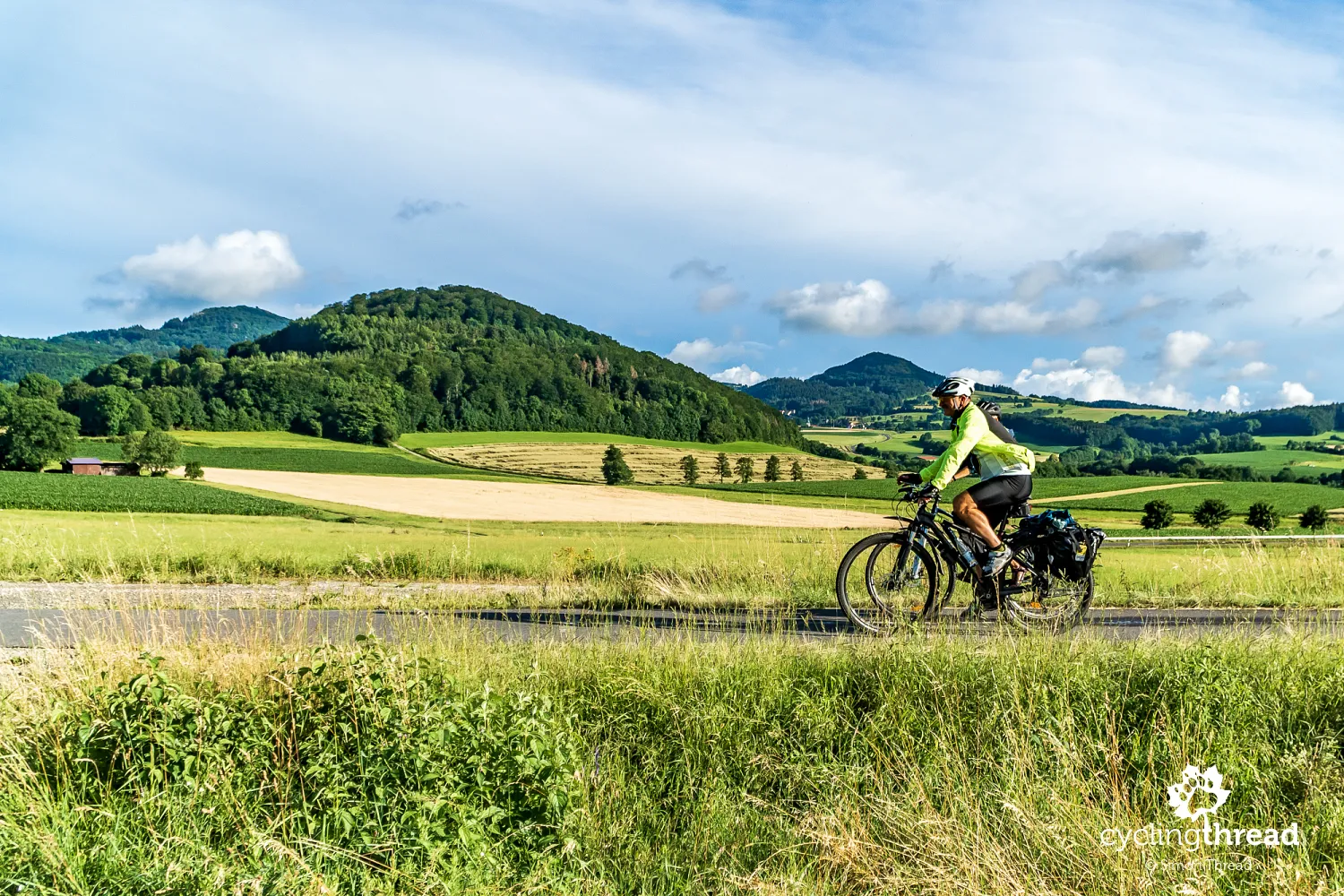
EuroVelo 13: the Iron Curtain Cycle Route
Beyond the town of Hilders, where we spent our second night, we encountered the yellow and blue signs of EuroVelo 13 - the European Iron Curtain Cycle Route. This marked our arrival at the former border between East and West Germany, which divided the country and the world into two opposing sides of the Cold War for 45 years. The area that once formed the inner German border is now part of efforts to create the Green Belt of Germany (Grünes Band Deutschland), stretching nearly 1,400 kilometers from north to south. The Green Belt serves as both an ecological corridor and a natural haven for flora and fauna, while also being a prime location for outdoor activities such as hiking and cycling.
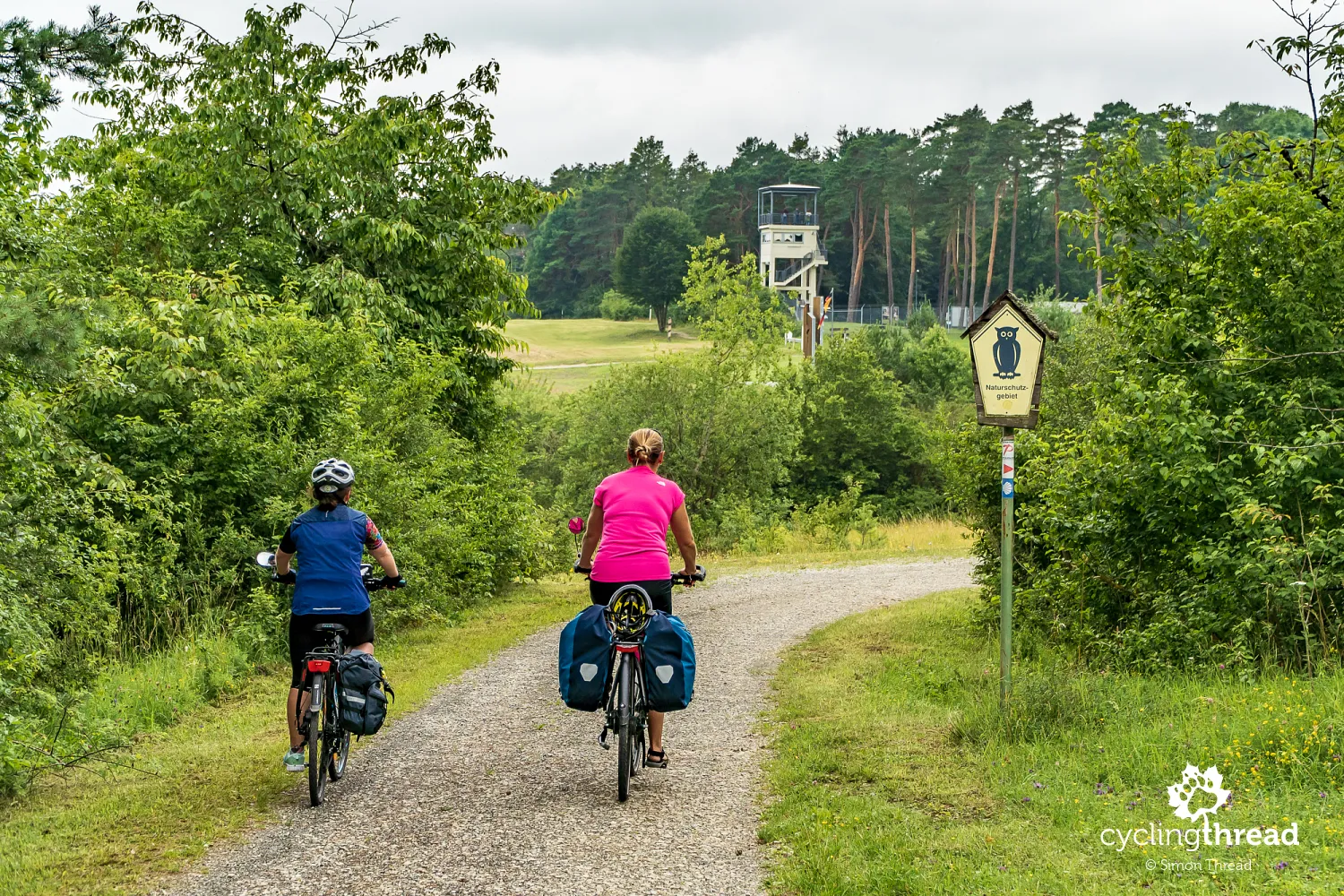
The Fulda Gap along EuroVelo 13
The route of EuroVelo 13 reminded us that we were traveling through the so-called Fulda Gap. This area in what was once West Germany overlaps significantly with our cycling trip along the Hesse Railway Cycle Route. The Fulda Gap includes two broad lowlands surrounding the Vogelsberg, extending toward Frankfurt am Main. NATO strategists considered it the most likely invasion route for Warsaw Pact forces during a Cold War conflict with the West. For years, this region was expected to be the site of a massive invasion of Soviet, Polish and other Warsaw Pact tanks aiming for Frankfurt. The most notable site associated with the Fulda Gap is Point Alpha, a former NATO observation and listening post, which we reached after a short but challenging and scenic climb from the nearby town of Geisa.
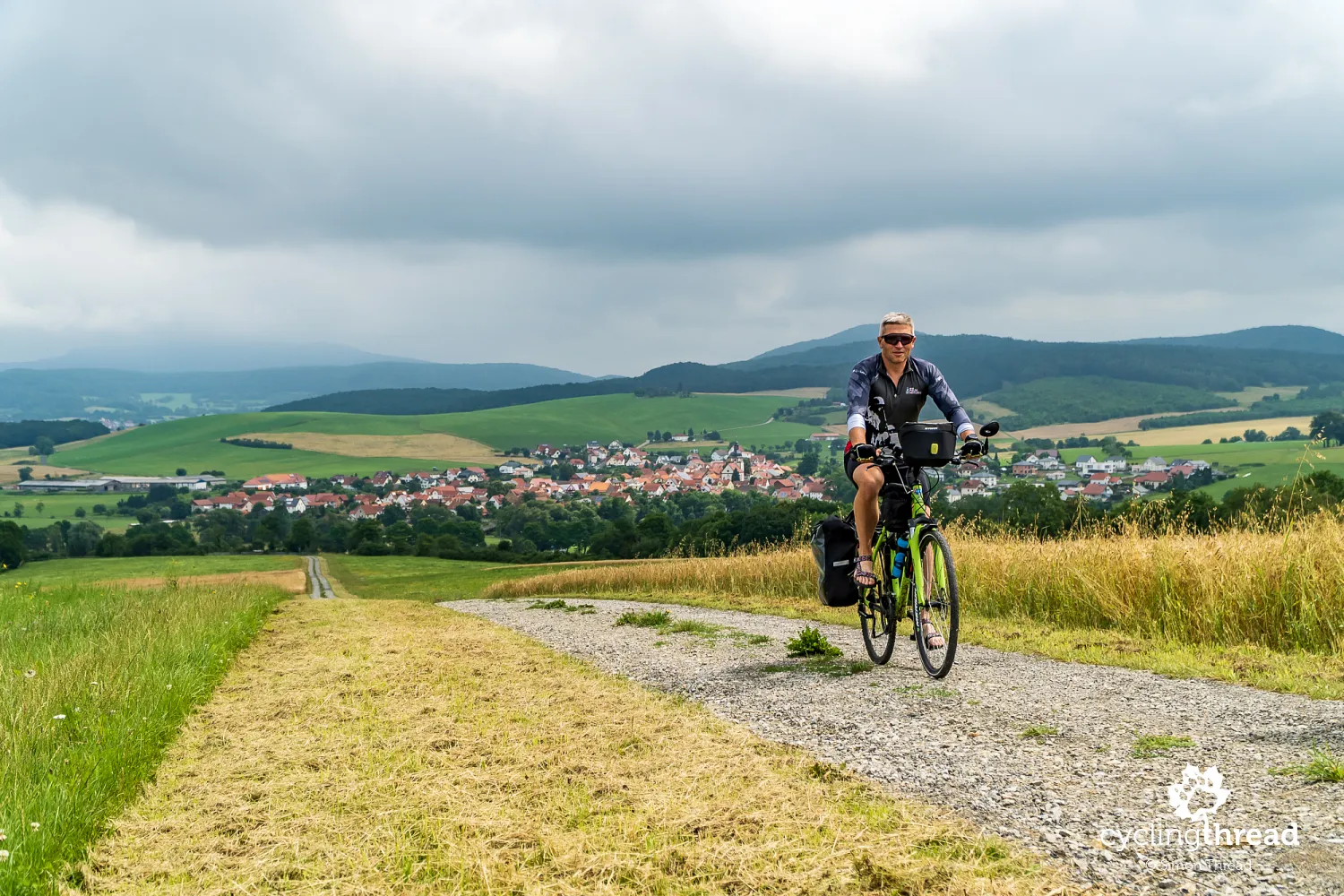
The hottest point of the Cold War
Point Alpha is often referred to as "the hottest point of the Cold War." Located on a hill above the Ulster River valley, the former border post has been one of Germany’s most important memorial sites since 1991, focusing on Europe’s postwar history and the division of Germany. Visitors can climb the military observation tower overlooking the former East German guardhouse and explore the barracks once occupied by the American military, now home to fascinating multimedia exhibitions. Outdoors, there’s a display of military equipment, including tanks and patrol helicopters used in the region. A bike visit to Point Alpha is also an opportunity to ride a preserved section of the border between East and West Germany, extending southwest from the site.
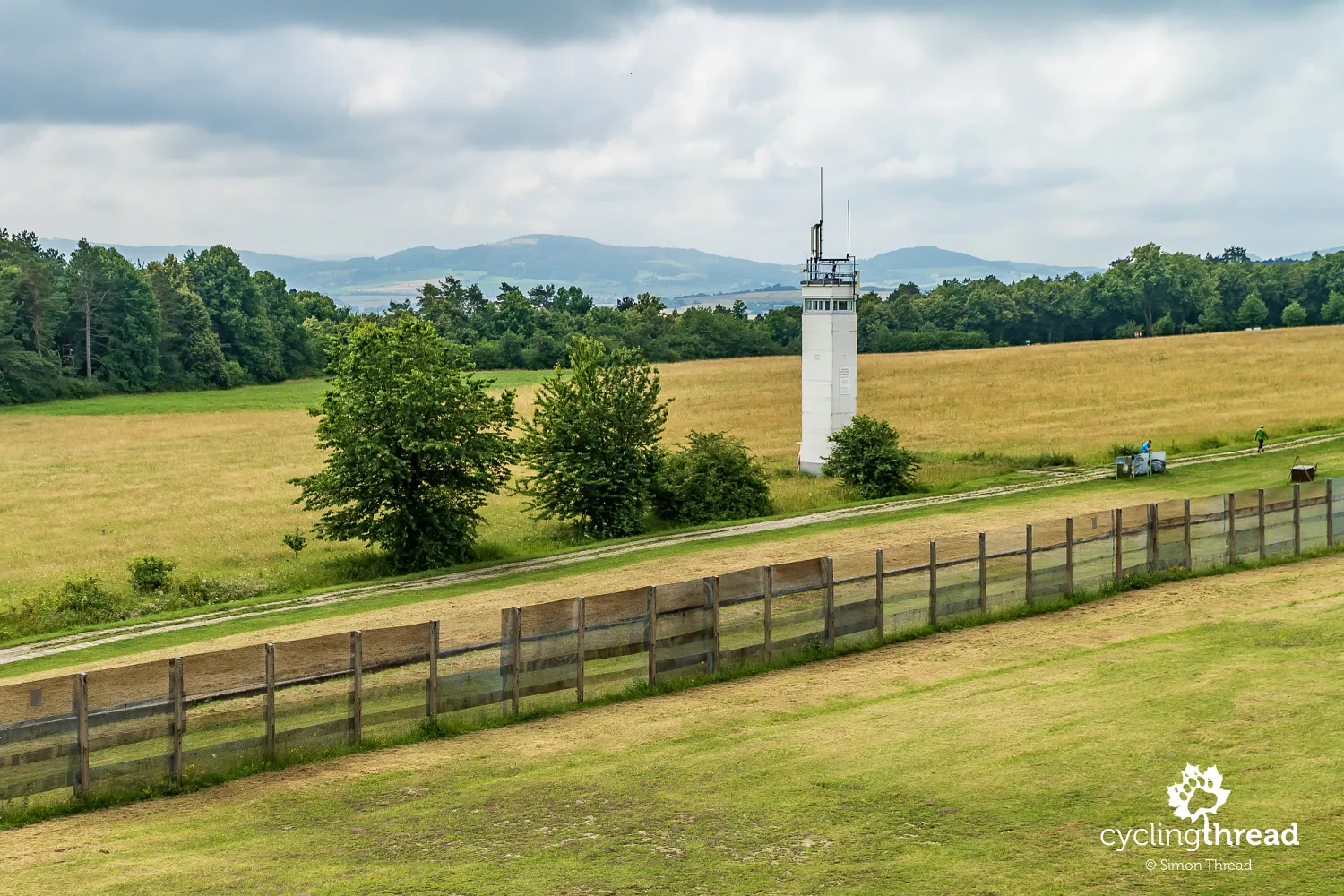
A railway bike path through the Hessian Kegelspiel
Point Alpha bid us farewell with a fast descent toward the last post-railway bike path on our route - the Kegelspielradweg. This route runs along what is considered one of the most scenic disused railway lines in Hesse, passing through the Hessisches Kegelspiel ("Hessian Bowling Pins"). The name comes from the dense cluster of small volcanic cones scattered across the area between the Ulster and Haune river valleys. Unfortunately, what looked so promising on the map and seemed to promise stunning views left me quite disappointed. From the old railway line, which the Kegelspielradweg now follows, the silhouettes of the “bowling pins” were not visible at all. Paradoxically, the section I had the highest hopes for turned out to be the least impressive of our Hessian post-railway adventure.
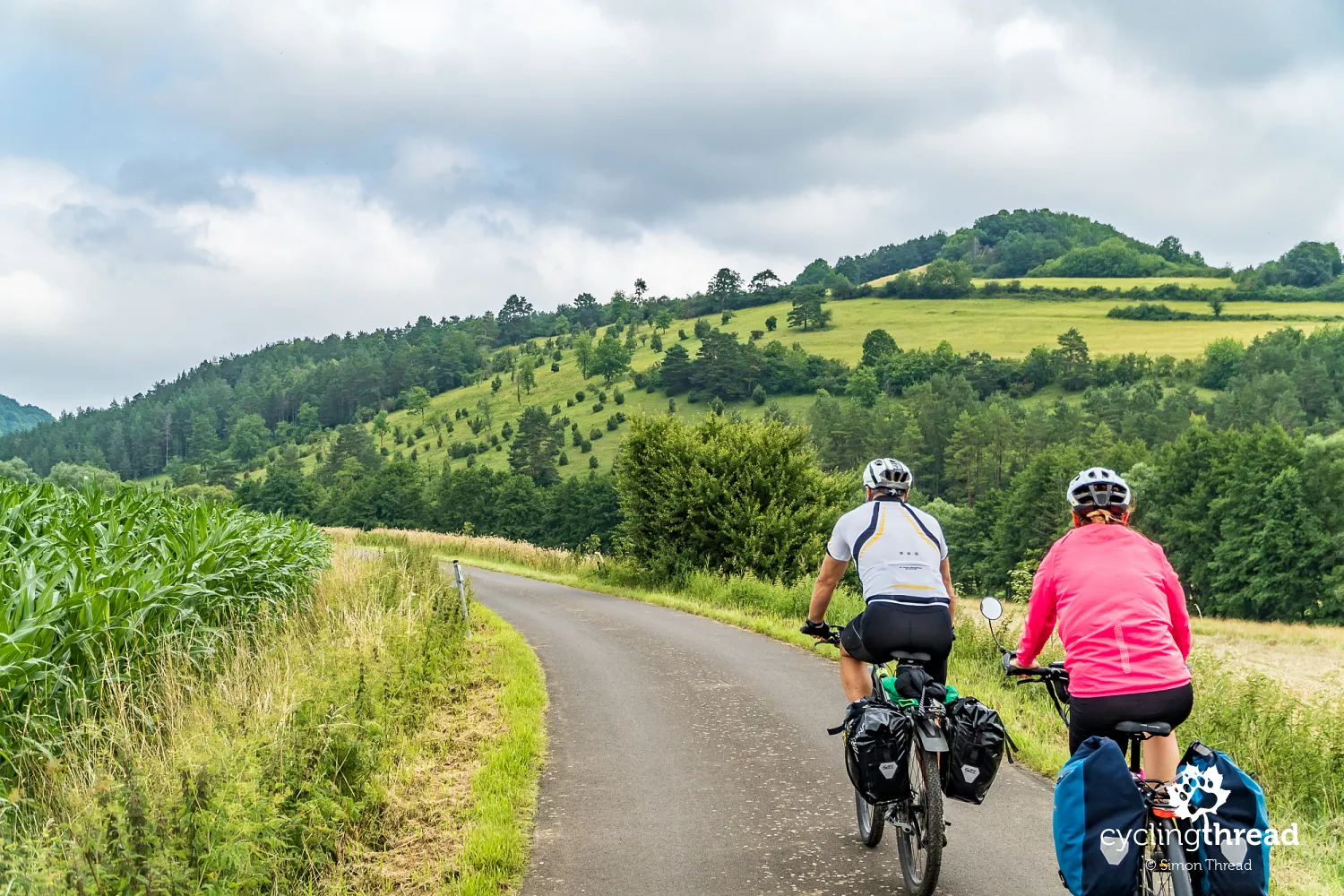
The impressive bridge on the cycling route
A spectacular feature on the otherwise slightly disappointing route through Hessisches Kegelspiel is the Klausmarbach railway bridge, built in 1906. This 32-meter-high structure was once part of the Hünfeld–Wenigentaft-Mansbach railway line. After rail services ceased, the bridge was transformed into a historical cycling bridge. One half of the bridge is now a bike path, while the other half serves as a rest area for cyclists. There some of us took advantage of the benches and tables for a short nap, while others explored the history of the bridge, detailed on the informative board standing nearby.
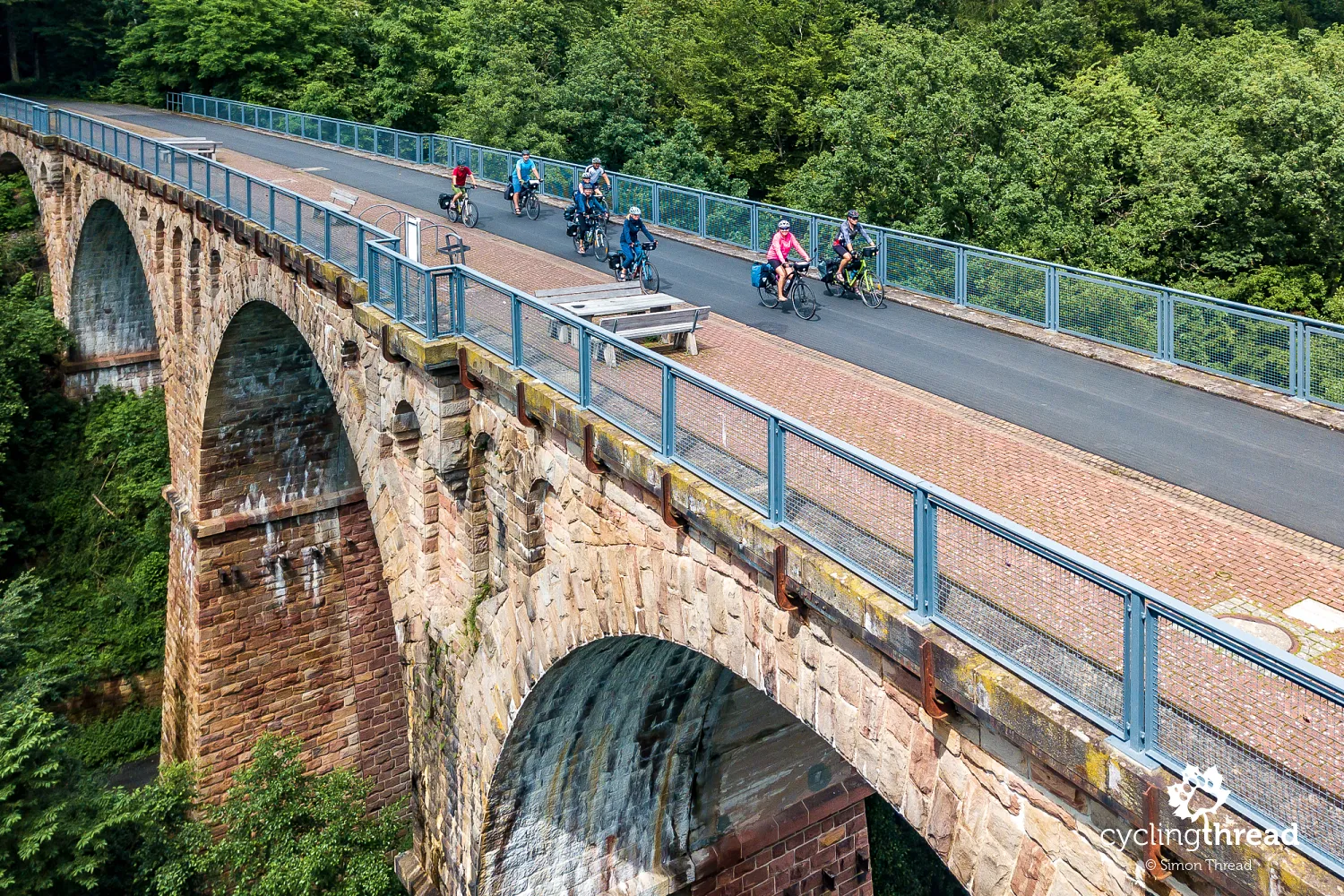
The railway route ends in Bad Hersfeld
Our first extended encounter with Hesse concluded in Bad Hersfeld. The Hesse Railway Cycle Route turned out to be an excellent inspiration for exploring this area and is undoubtedly a unique gem among Europe’s cycling routes. While the route doesn’t pass through Germany’s most famous attractions, the opportunity to cover relatively long distances by bike along former railway lines is a rare treat. Looking back on the scenic rows of half-timbered houses and the taste of roasted pork shoulder washed down with cold beer in a Fulda beer garden… our trip to Hesse was both enjoyable and enlightening. It showcased numerous thoughtful solutions that can genuinely delight cycling tourists.
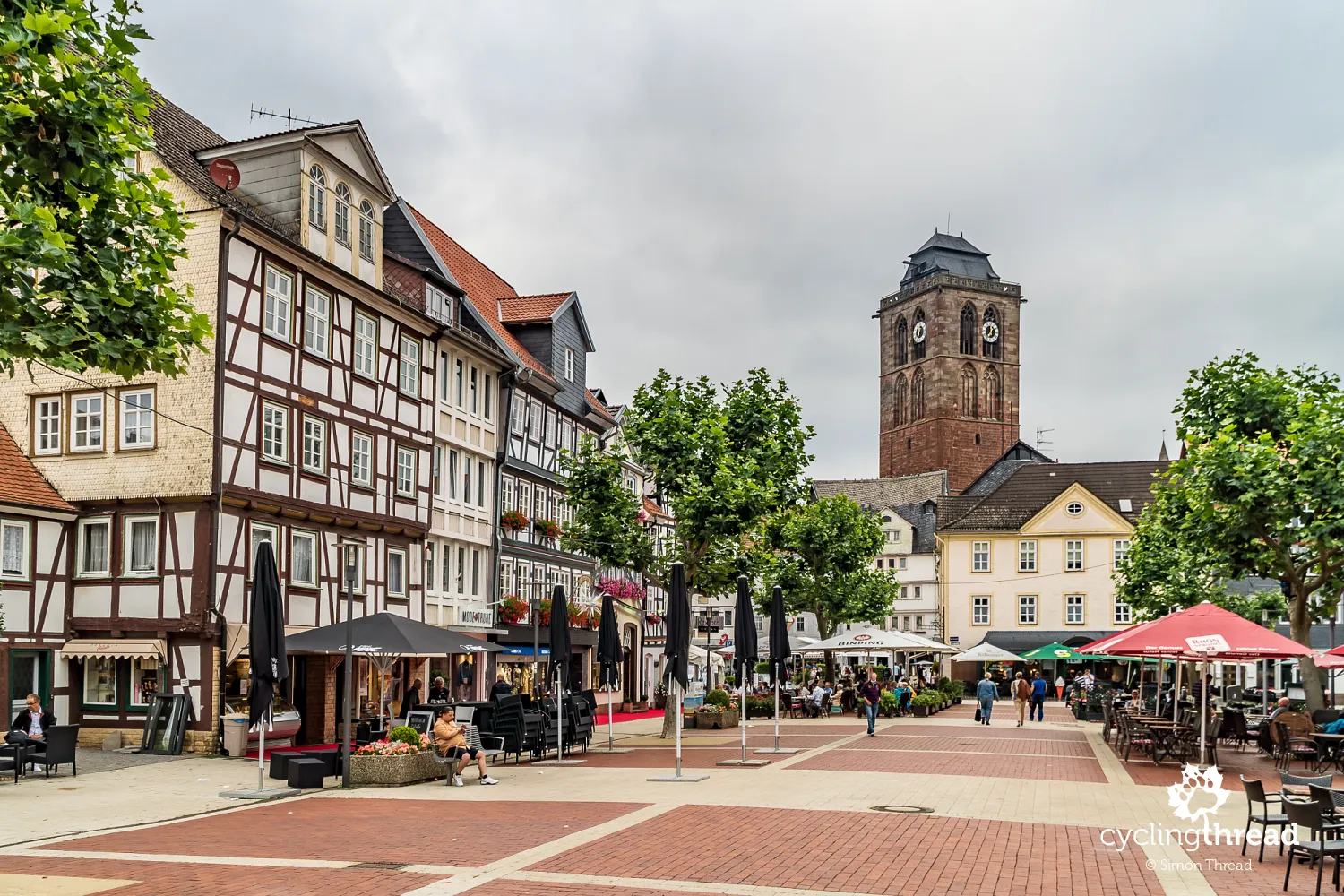
Easy to get there from Frankfurt
The Hesse Railway Cycle Route is easily accessible by train. Hanau and Fulda are key stations on the main rail line connecting Berlin and Frankfurt am Main. For train enthusiasts, the journey itself can be a highlight, especially on Deutsche Bahn’s high-speed ICE trains (similar to Pendolino), which also accommodate bicycles - just remember to take advantage of discounted fares by booking early! For our trip, we reached Altenstadt, our starting point, via a regional train from Frankfurt am Main, where we stayed overnight. This adjustment - starting in Altenstadt instead of Hanau - allowed us to tailor the first day’s distance to match our lodging reservations. If you manage to start in Hanau, the official starting point of the Hesse Railway Cycle Route, you’ll enjoy the route from its very beginning.
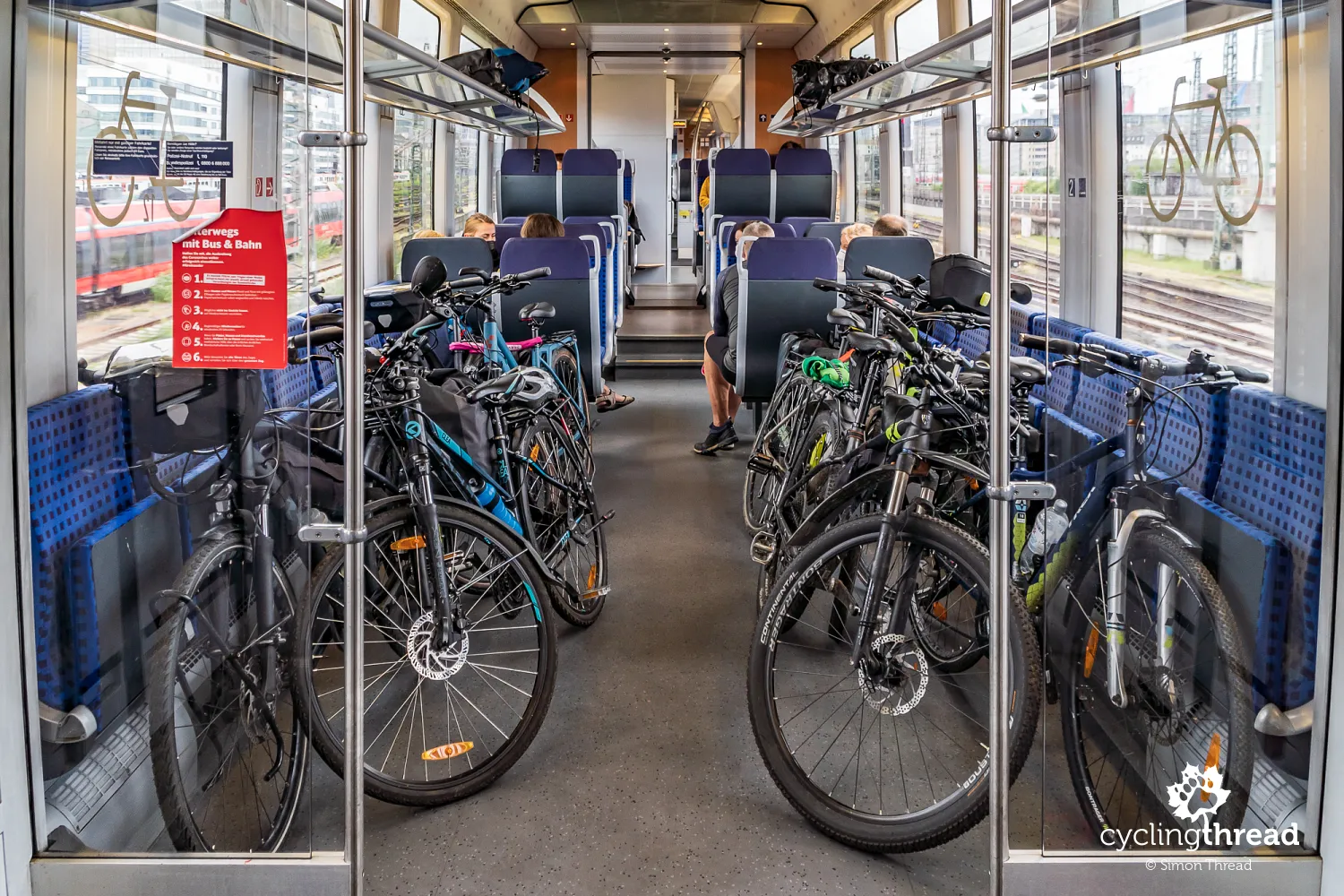
Hotel, guesthouse, two apartments, and a motel
In Hesse, we stayed in accommodations booked via Booking.com: a chain hotel in central Frankfurt am Main, a guesthouse in Lauterbach, two apartments in Hilders (the second one nearby), and a hotel-motel in Bad Hersfeld. We found a great deal on the hotel in Frankfurt, while the two separate accommodations in Hilders were a result of limited availability in that area, chosen to maintain our daily cycling distances at around 70 kilometers. Overall, we felt that this region had a less touristy vibe, which might explain the smaller number of lodging options. One thing you can be certain of on the Hesse Railway Cycle Route - you won’t experience overtourism here.
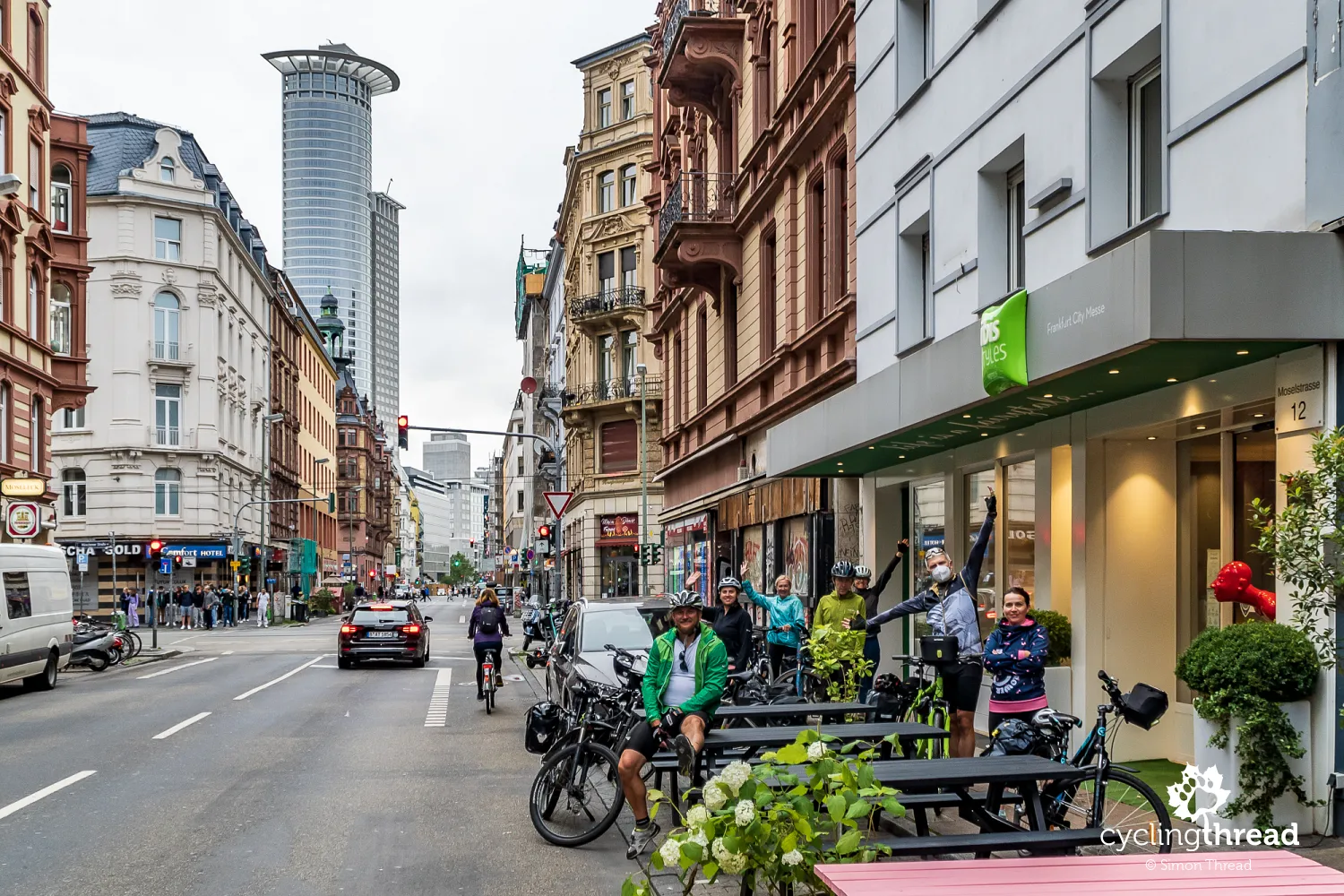
Plan your summer cycling trip in winter
When planning a cycling trip to Germany, remember this key piece of advice I often share: planning should start in winter, and by early spring, lodging reservations should be finalized. Germans are not only avid cyclists but also highly organized planners who book everything well in advance. To secure the best accommodations that align with convenient daily cycling distances and to take advantage of lower prices, it’s essential to start planning your cycling trip to Germany at least 4-5 months before your travel date. Good luck!
Back to top


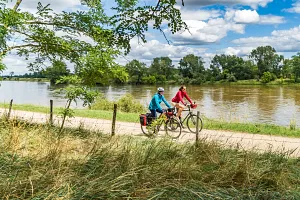
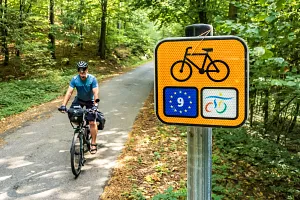
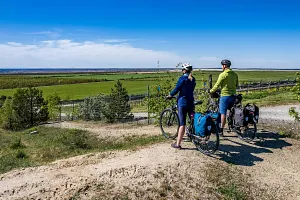
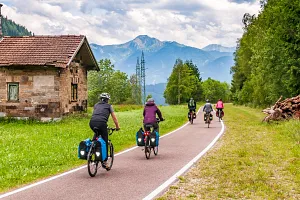
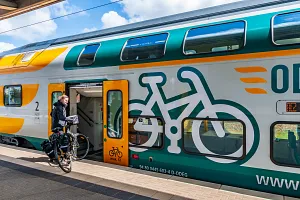
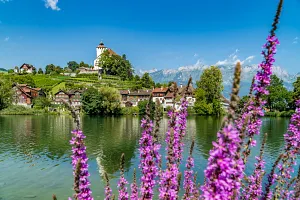

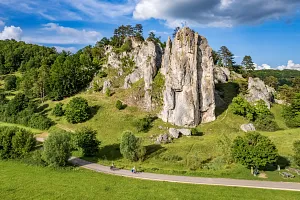
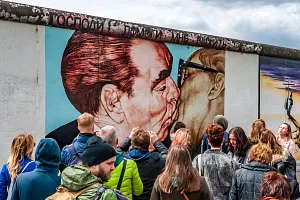
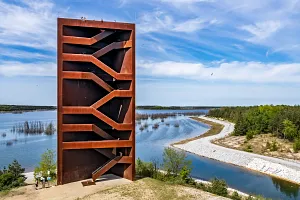


Your Comments
Add new comment